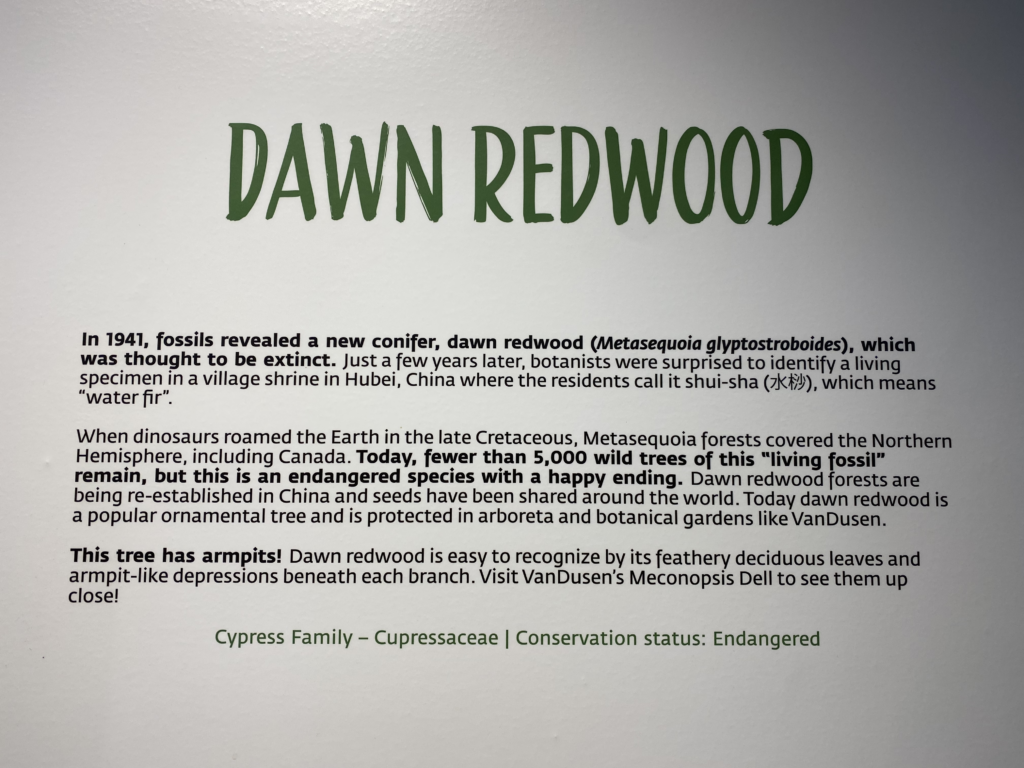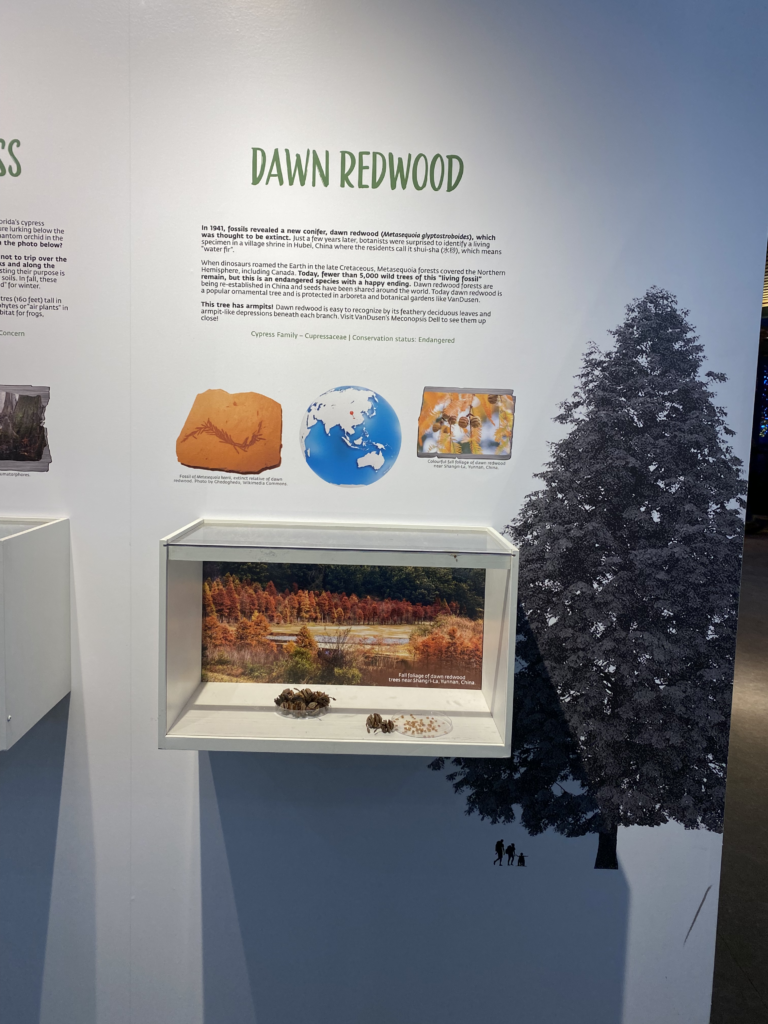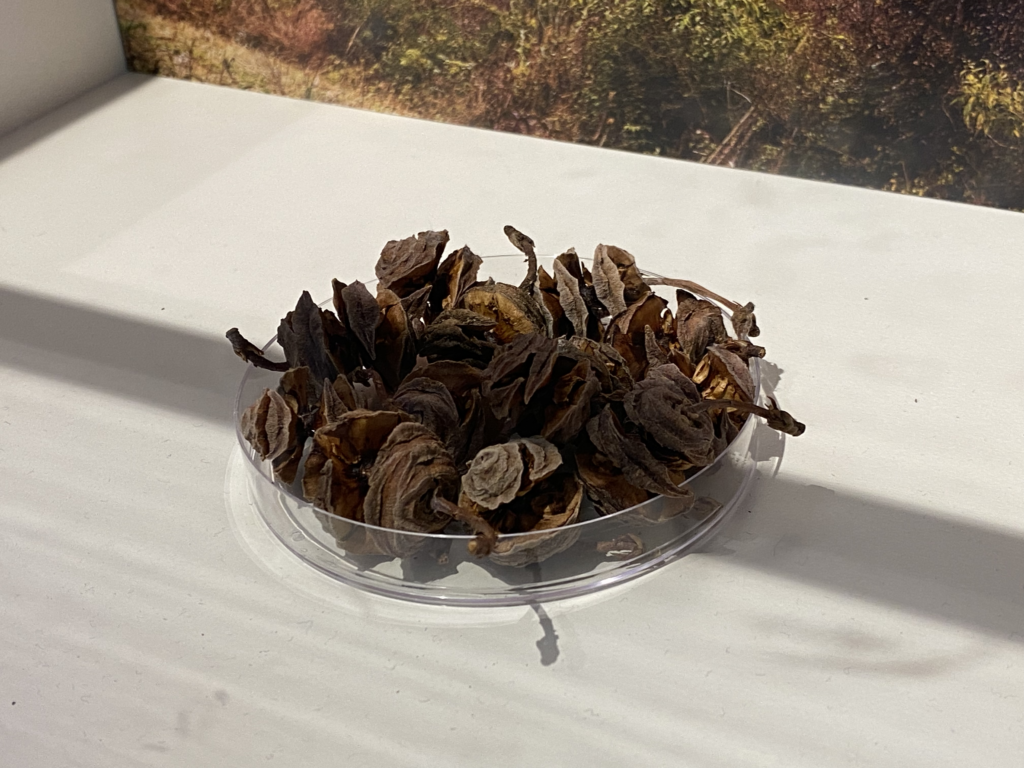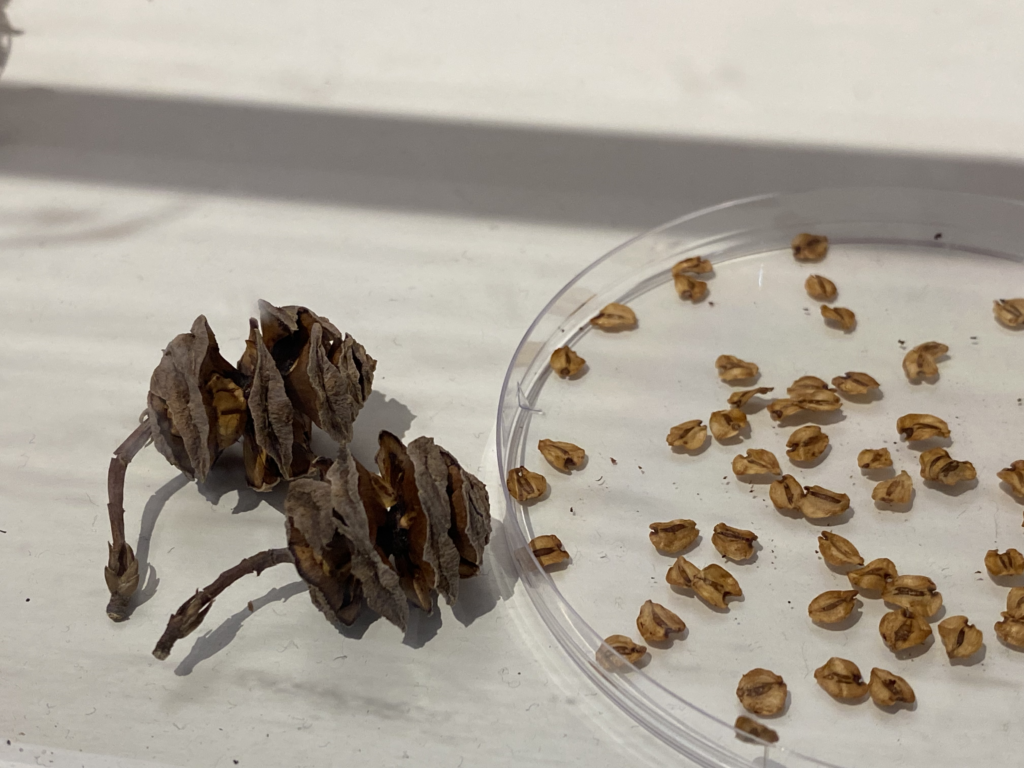Learning all about conifer trees at the VanDusen Botanical Garden Conifer Connect exhibit.
Conifer Connect
Did you know the oldest, tallest and largest trees on Earth are all conifers?
Conifers are also critical in our fight against climate change with research showing coniferous forests absorb two and a half times as much carbon from the atmosphere as broadleaf forests!
Here on the coast of the Salish Sea, we are in the heart of the largest temperate rainforest on Earth. From the Pacific coast of Alaska to northern California, it is dominated by conifers like western redcedar, Douglas-fir and Sitka spruce which grow to record sizes in our wet, mild climate. With a lush understory of decaying wood, moss, lichens, fungi, ferns and berry plants, these forests protect our precious watersheds and salmon-bearing streams. They are also home to endangered Pacific salamanders, Pacific tree frogs, slugs, deer, wolves, cougars and bears, including the endangered Kermode or spirit bear.
Explore this exhibit to learn about these cone-bearing trees and how we connect with conifers through food, medicine and culture.
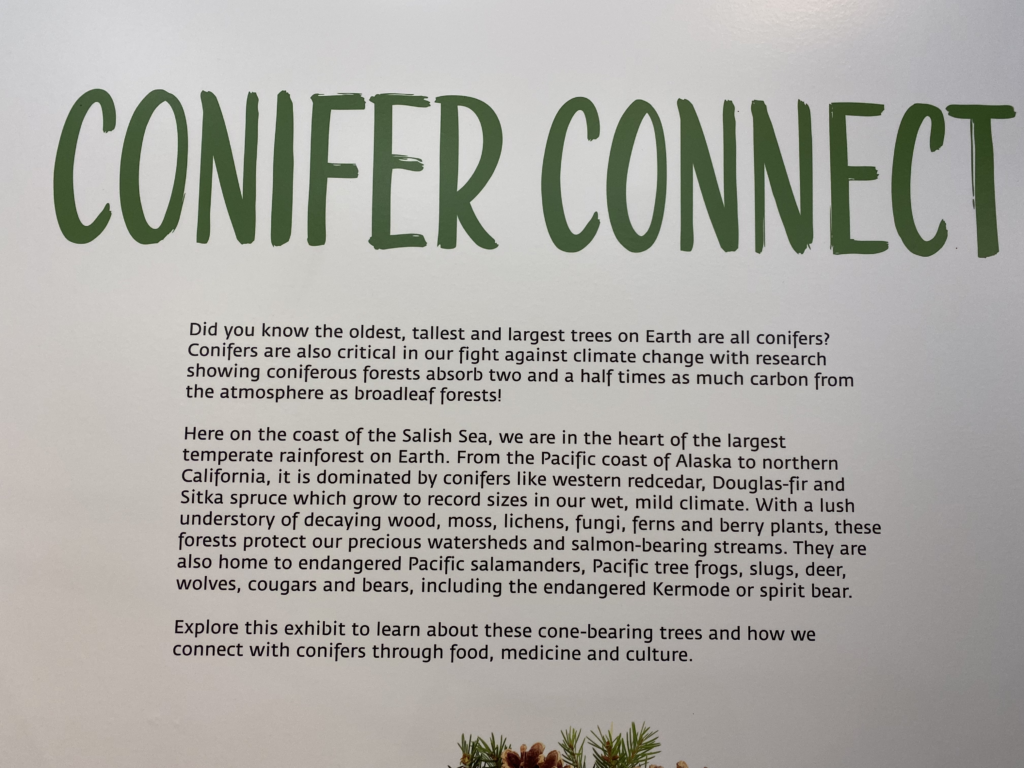
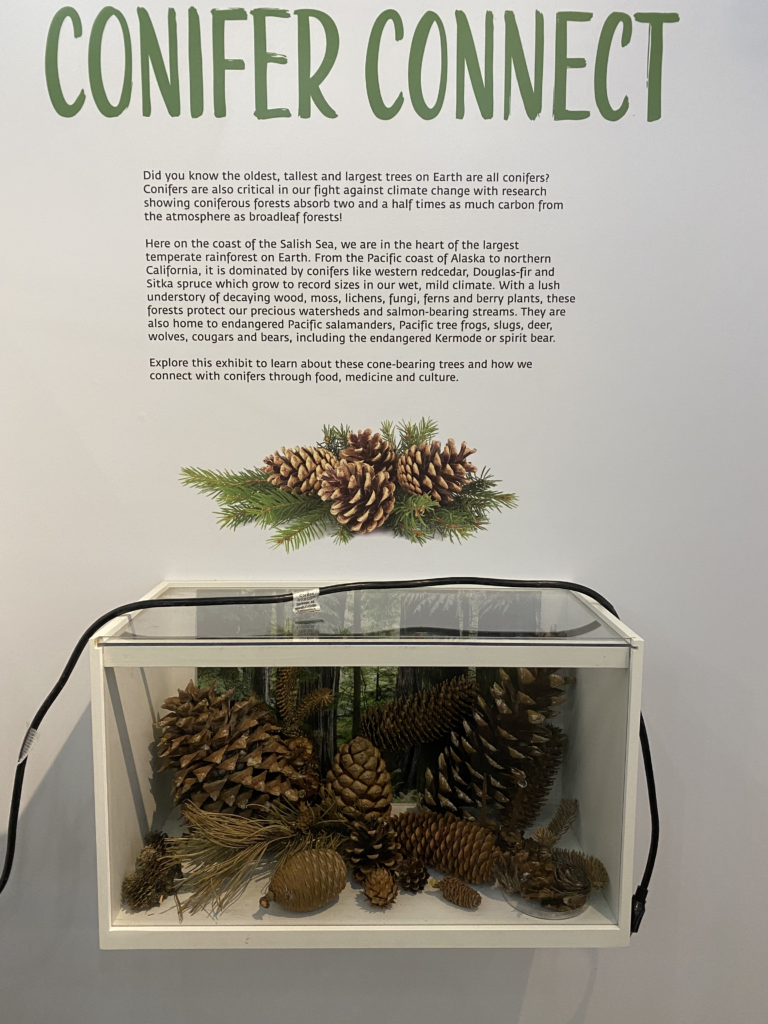
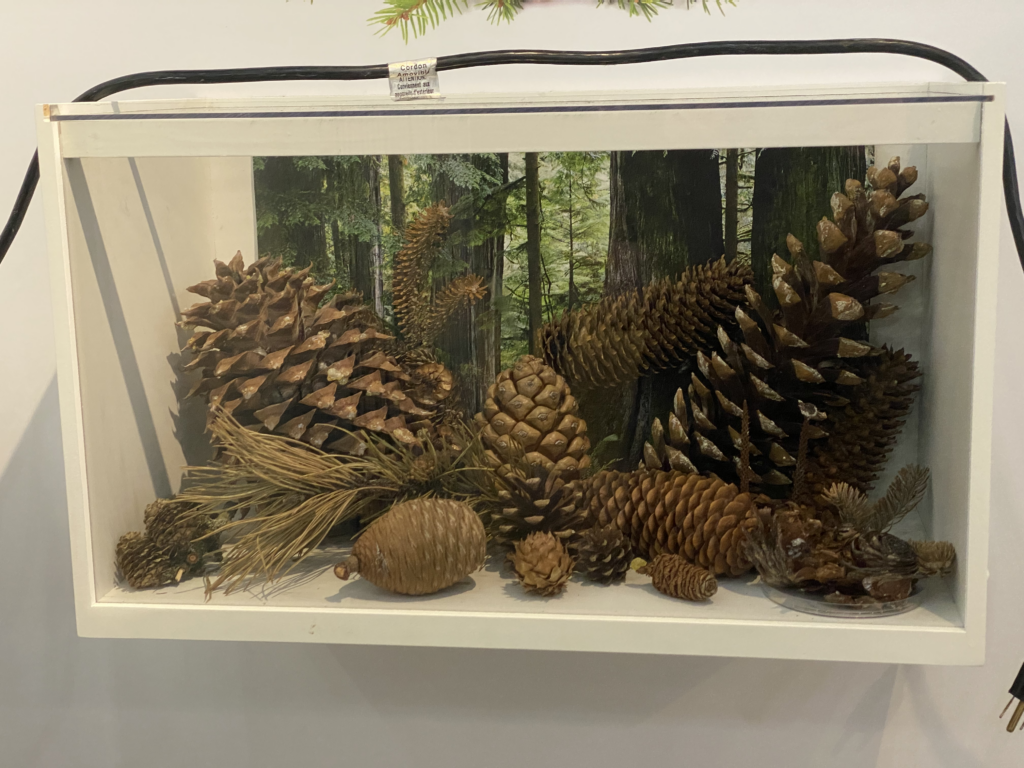
Wollemi Pine
Dangling from a helicopter in a remote rocky gorge, a botanist reaches out to collect cones from the top of one of the rarest trees on Earth. This is to avoid climbing the tree with spiked boots and damaging its strange bark, which looks like bubbling chocolate.
In 1994, Wollemi pine made headlines as the botanical discovery of the century. A conifer described from fossils and believed to have died out with the dinosaurs, had just been found alive! While hiking in Australia’s Blue Mountains in New South Wales, parks officer David Noble stumbled upon a hidden grove of trees like nothing he had seen before. This new species was named Wollemi pine (Wollemia nobilis) for its home, Wollemi National Park, and for David Noble.
100 million years ago, Wollemi pine grew across the southern hemisphere but today fewer than 100 trees of this “living fossil” remain. These narrowly escaped being wiped out entirely by Australia’s unprecedented bushfires in 2020! Still, the Wollemi pine is a conservation success story, thanks to Wollemi Pine International and other organizations who propagate and distribute trees globally to support research and conservation.
Araucaria Family – Araucariaceae | Conservation status: Critically Endangered
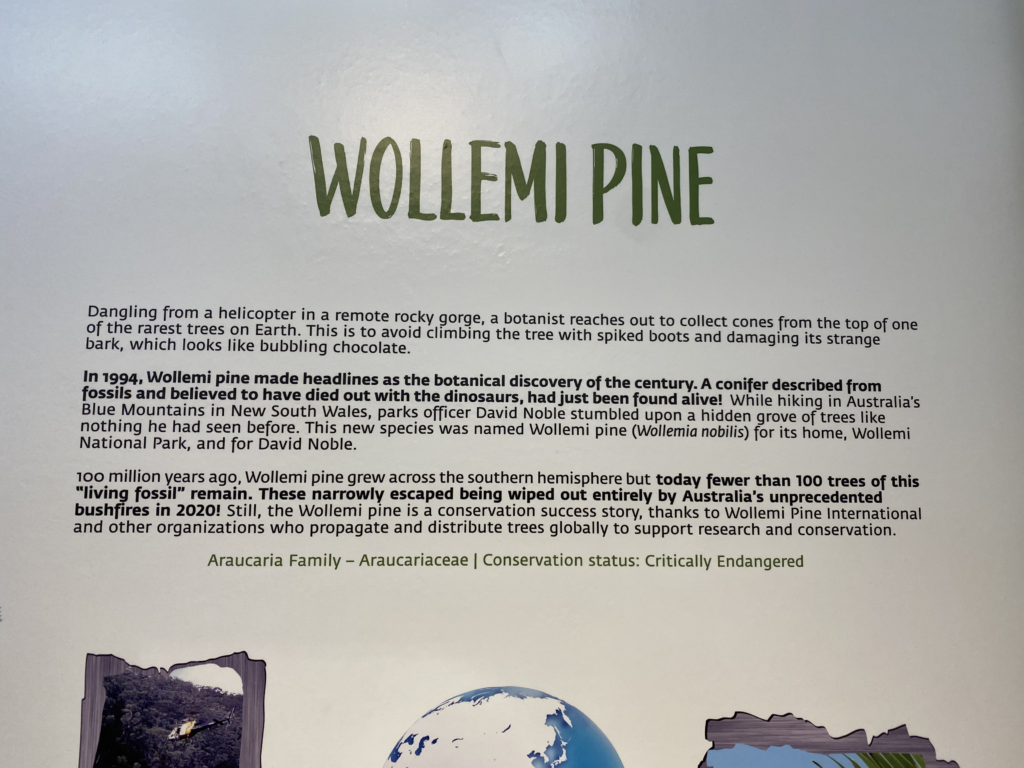
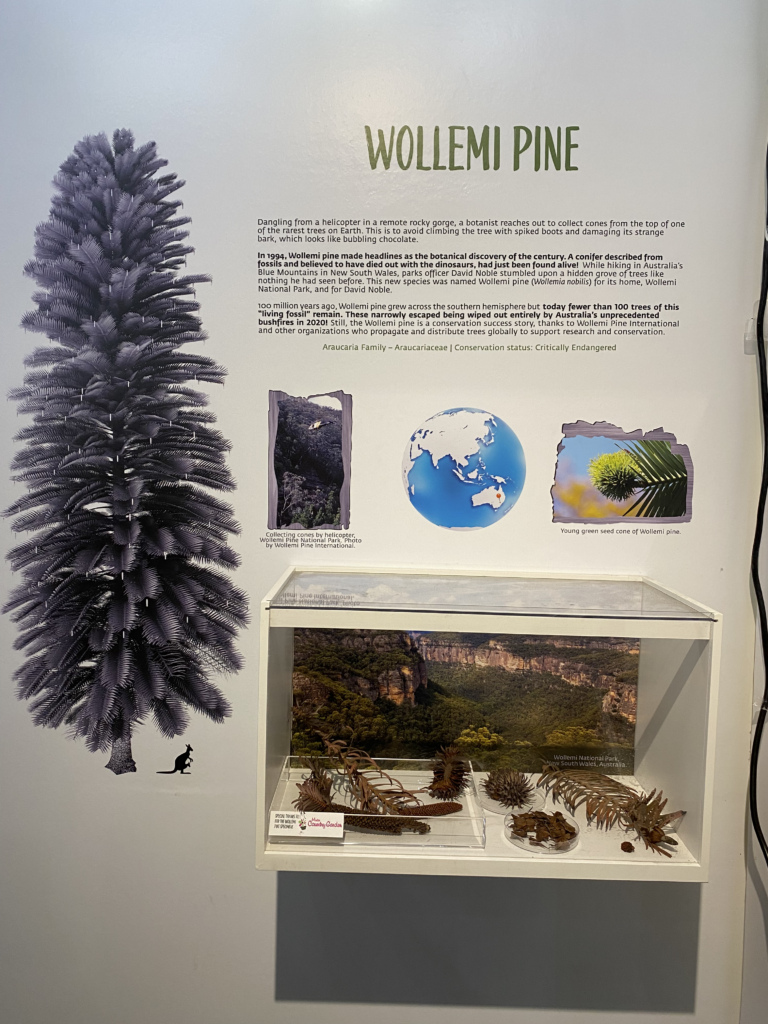
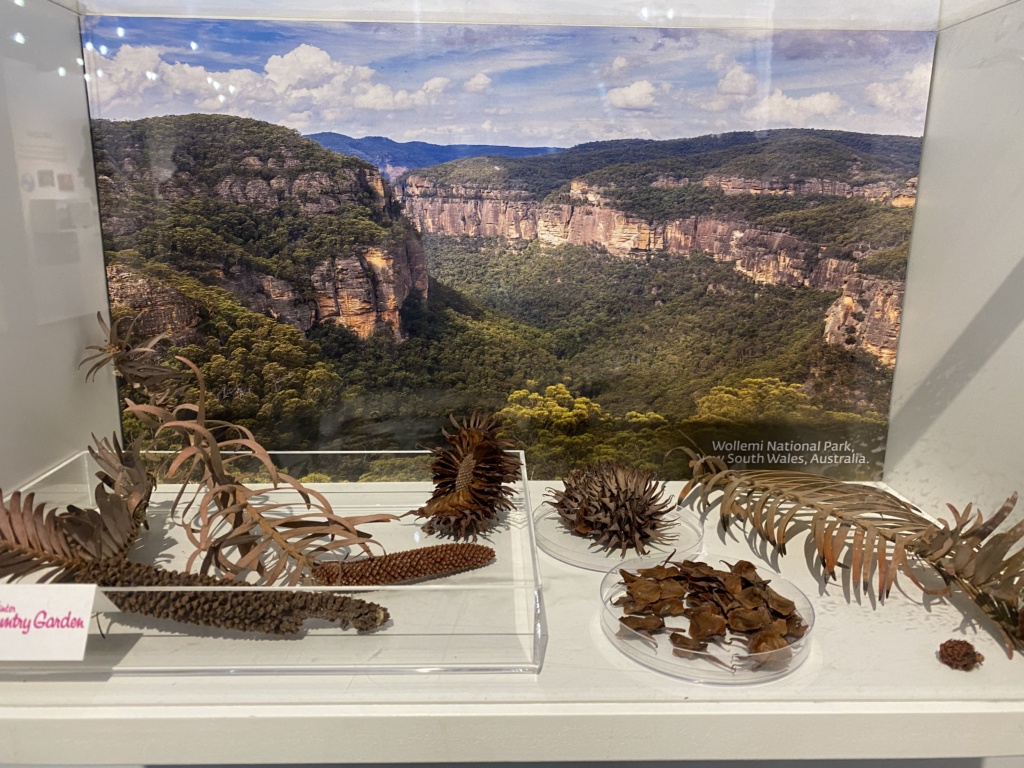
Pacific Yew
Does medicine grow on trees? Yes! Of the medicines we use today, 70% are derived from natural sources and at least 40% come from plants. While many of the world’s estimated 70,000 medicinal plant species are threatened by habitat loss and over-harvesting, botanical gardens and arboreta are working together to conserve these plants in living collections and support conservation efforts in the wild.
Pacific yew (Taxus brevifolia) grows in the shadow of towering Douglas-firs and western red cedars in the Pacific temperate rainforest. But Pacific yew is a giant in its own right. Its bark contains paclitaxel, also known as taxol, an important tool in the fight against cancer. High demand for this chemotherapy drug led to overharvesting and was threatening Pacific yew, but scientists learned to synthesize paclitaxel in the lab so now wild populations can recover.
A conifer without cones, Pacific yew has seeds surrounded by juicy red arils that attract birds who eat and disperse them. But don’t add these to your next smoothie! Except for the aril itself, the entire plant is poisonous.
Yew Family – Taxaceae | Conservation status: Near Threatened
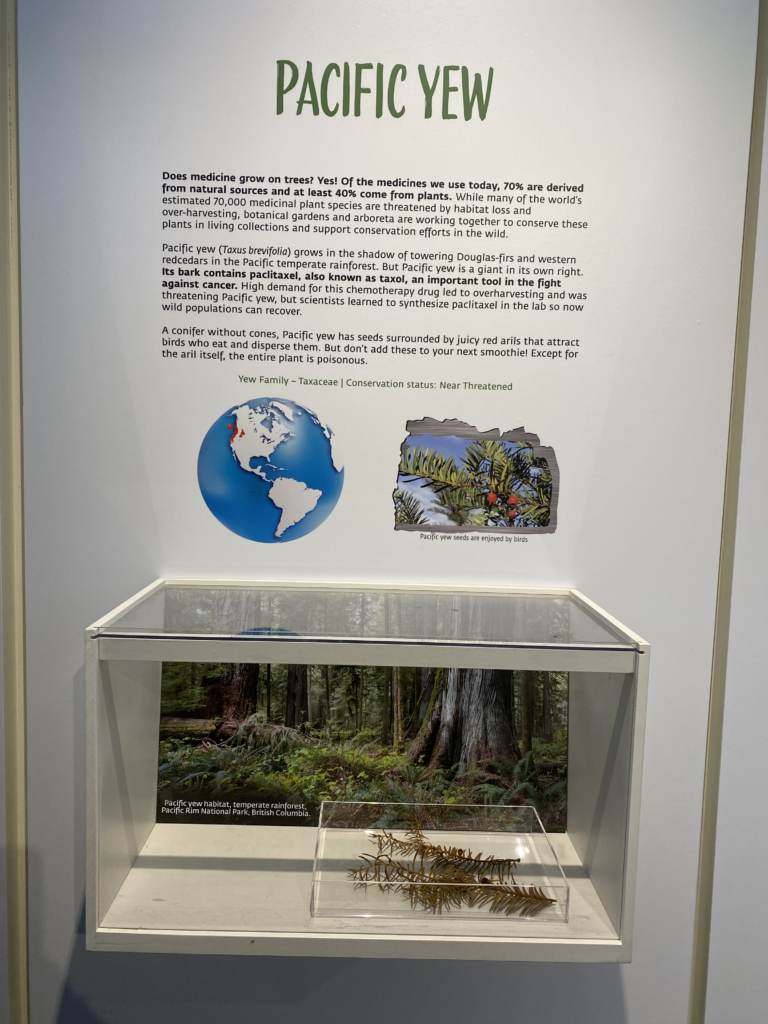
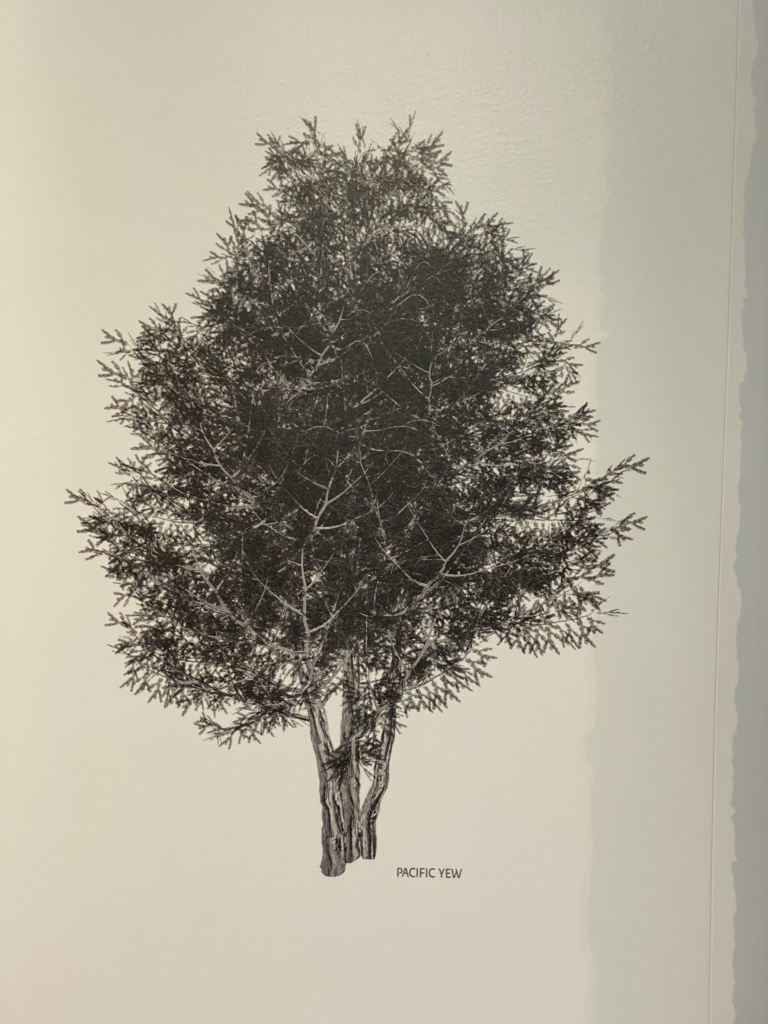
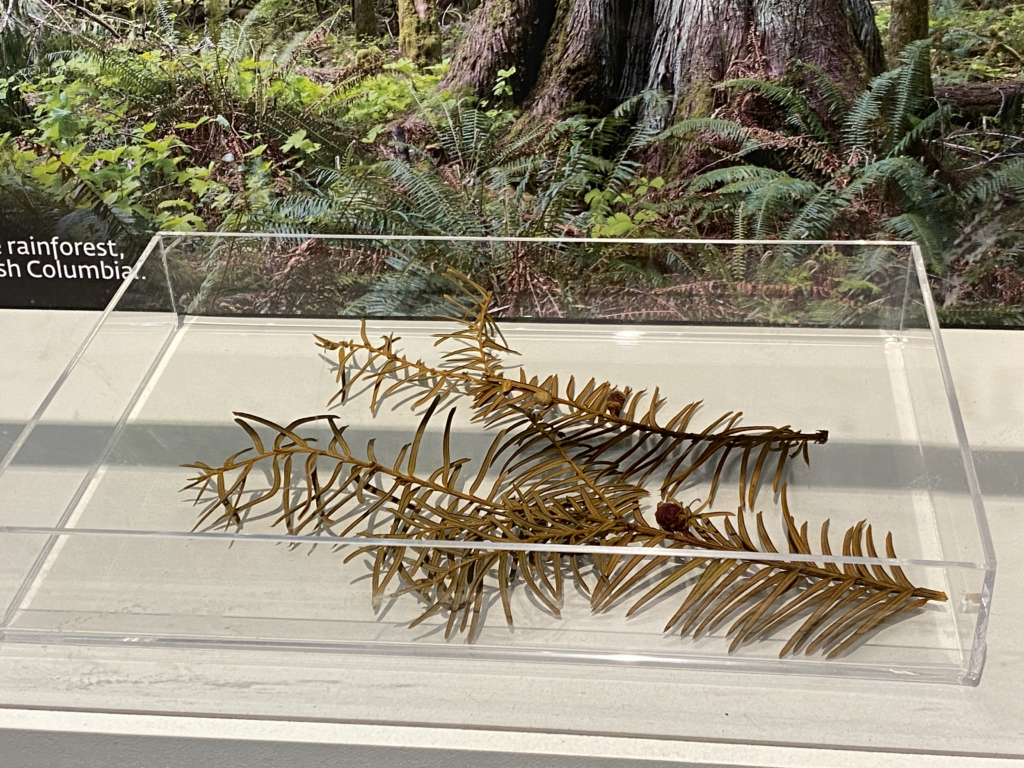
Tree of Life
Western redcedar (Thuja plicata) is known as the tree of life (xpeÿatp in hanqaminam and xápay’ay in skwxwú7mesh) to the x”ma0kayam (Musqueam), skwxwú7mesh (Squamish) and salilwatat (Tsleil-Waututh) Nations, on whose unceded land Vancouver occupies.
A must-read, Cedar by Hilary Stewart describes how cedar wood is used to build post and beam houses and master carvers create ocean-going canoes or story poles from a single tree. The fragrant, naturally insect-repellant and rot-resistant wood is also carved into ceremonial masks or steamed into bentwood boxes. Woven clothing, bedding, floor mats, rope and fishing tools are crafted from the bark, roots and branches. To protect the tree of life for future generations, First Nations peoples developed a way to harvest wood planks and bark from a tree without killing it.
In the Pacific temperate rainforest, from Alaska to northern California, the tree of life can live for over 1,000 years and reach 70 metres (230 feet) tall. After death, decaying cedar stumps or “nurse logs” nurture new life moss, fungi, ferns, shrubs and seedlings of the next generation of trees.
Cypress Family – Cupressaceae | Conservation status: Least Concern
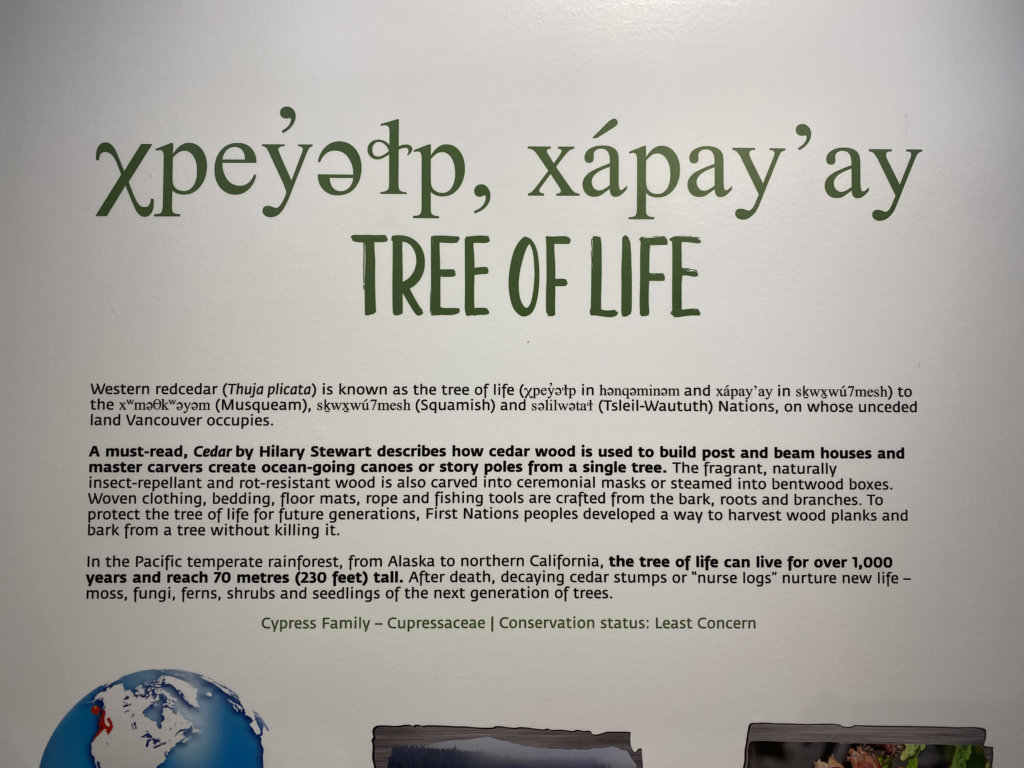
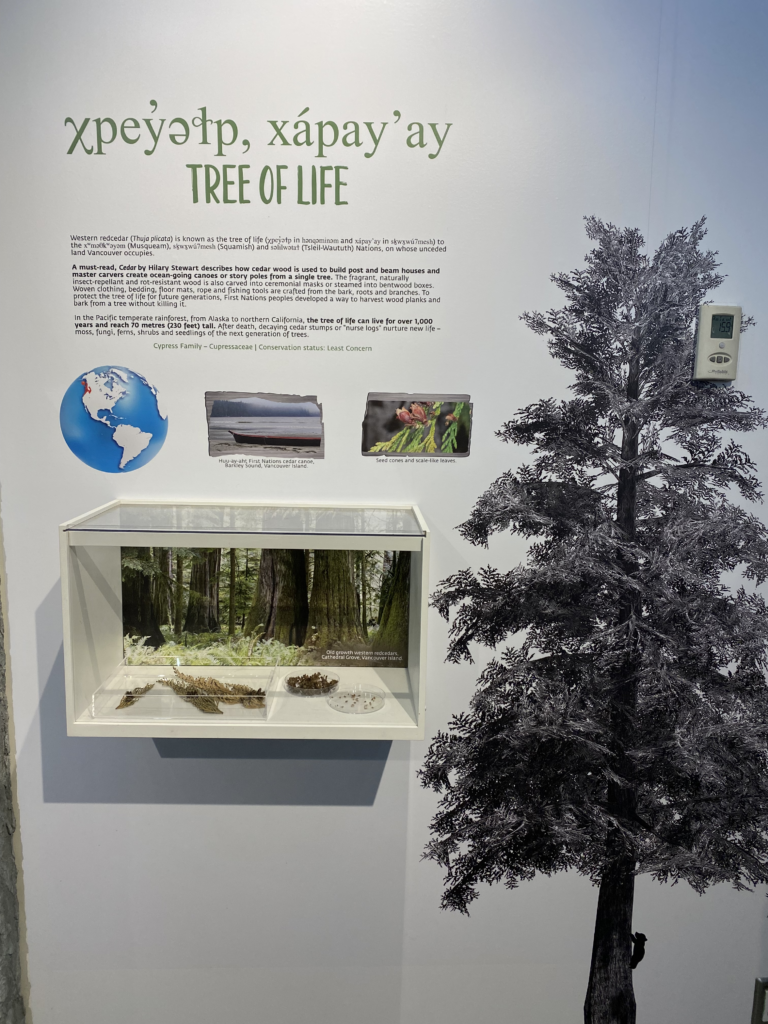
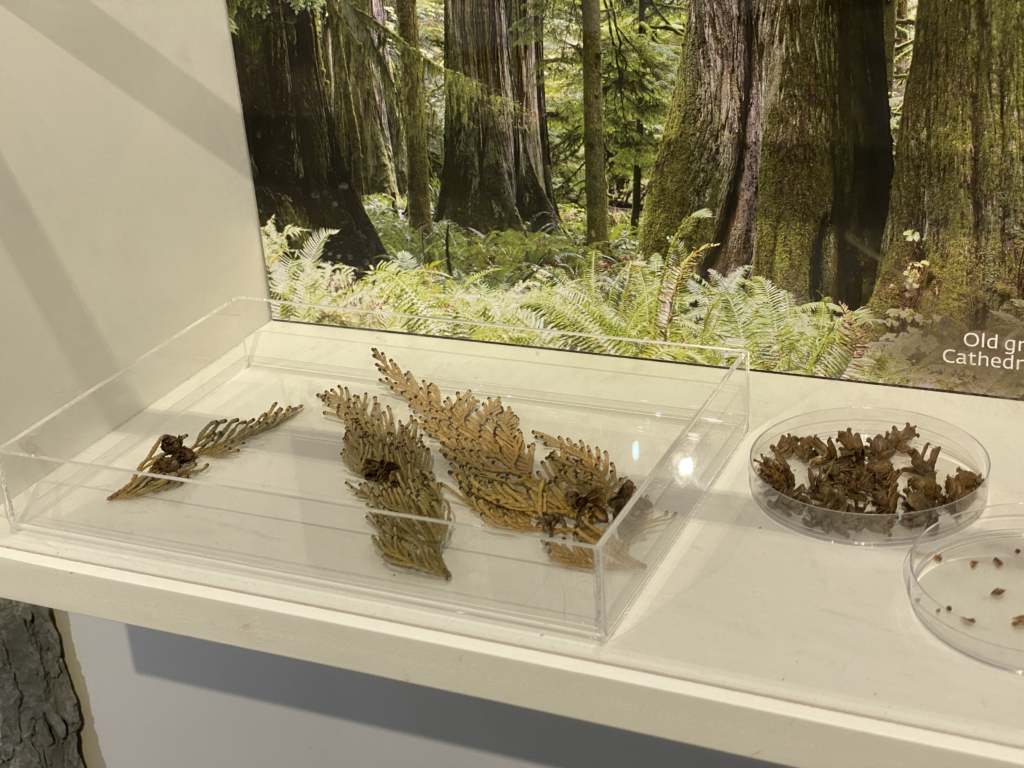
Ghost Pine
If the wind is blowing, avoid standing under a ghost pine! Its heavy, wickedly spiked cones can cause serious injuries but they are also a caloric goldmine.
Ghost or gray pine (PInus sabiniana) grows in the dry foothills of California and southern Oregon where the indigenous peoples have eaten its nutritious, oil -rich seeds for over 9,000 years. They also use the seeds as beads to make jewelry and clothing. The Ohlone peoples of Northern California call this tree saak, which means “pine nut”. Oak woodpeckers, Steller’s jays, scrub jays and small mammals also enjoy the seeds.
Try pine nuts raw, roasted or paired with salmon – a modern take on traditional dried smoked salmon and pine nut cakes. Ghost pine seeds are also ground up to make flour for baking or mixed with other ground seeds to make Pinole, a powder used to make drinks, porridge and flatbreads.
Pine Family – Pinaceae | Conservation status: Least Concern
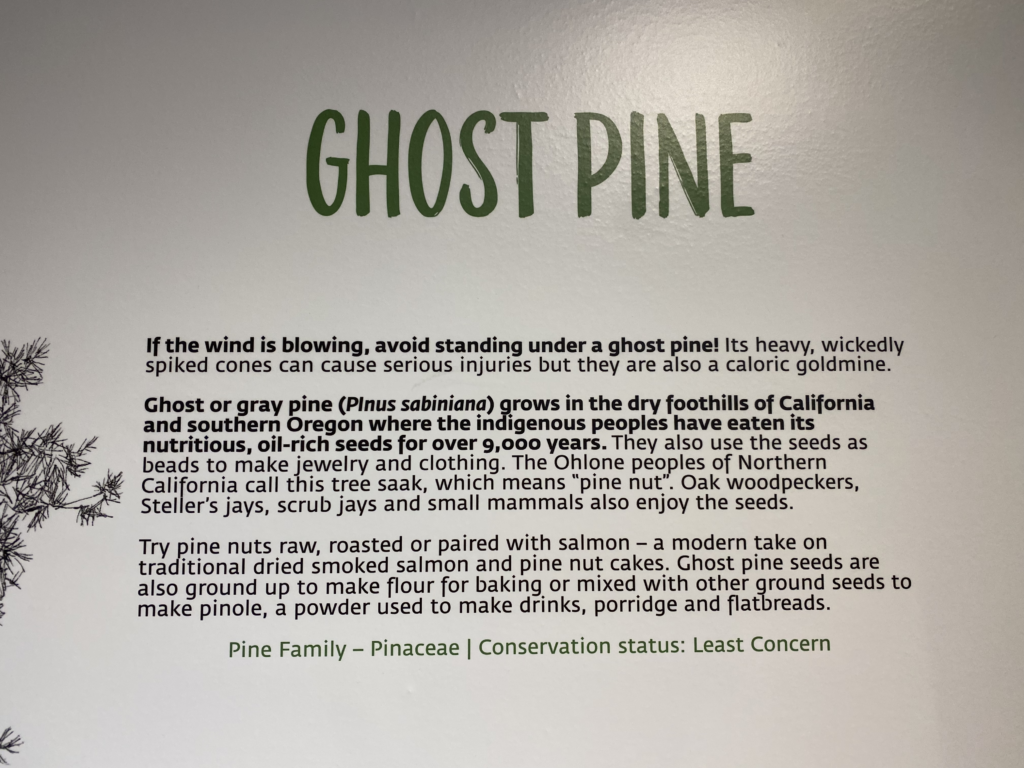
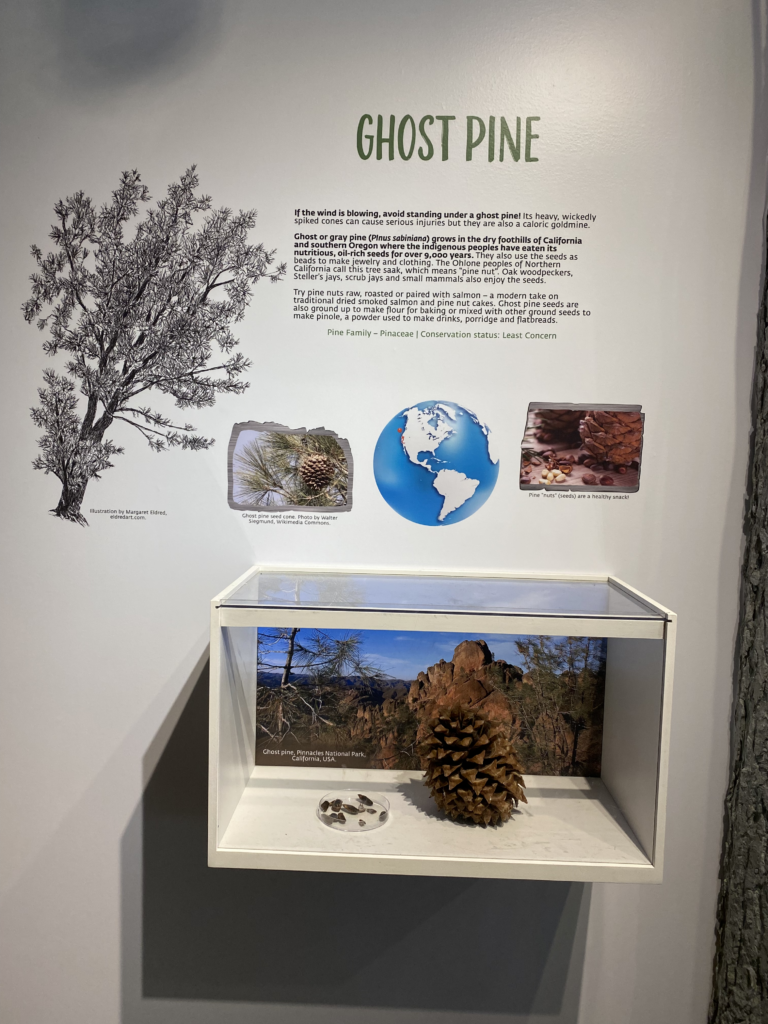
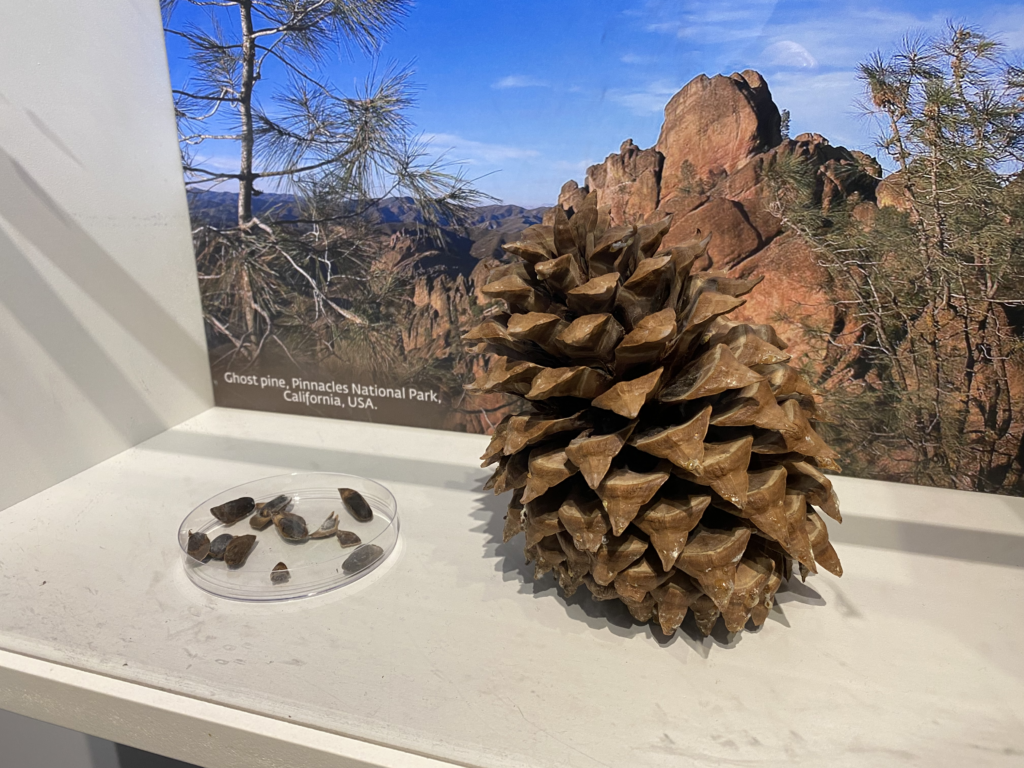
Giant Sequoia
Like an ant among giants, you are dwarfed by massive tree trunks all around you, some as wide as a house! These gentle giants can live for over 3,000 years and belong to the largest tree species on Earth by volume, the endangered giant sequoia (Sequoiadendron giganteum).
After decades of logging, fewer than 80,000 trees remain in California’s Sierra Nevada Mountains. Here, they are adapted to snowy winters, dry summers and seasonal forest fires, which giant sequoias need to release seeds from their cones and reproduce. Fire suppression, the greatest threat against this species, allows wood fuel to build up in the understory resulting in intense fires that even these thick-barked giants cannot survive.
In California’s Sequoia National Park, you can visit ancient trees like General Sherman, the largest living tree at 84 meters (275 feet) tall with a trunk 31 meters (102 feet) in circumference. This tree weighs an incredible 1.2 million kg (2.7 million pounds) – the weight of 10 blue whales! An even larger giant sequoia, felled by a storm in 1905, measured almost twice the size of General Sherman – the weight of 20 blue whales!
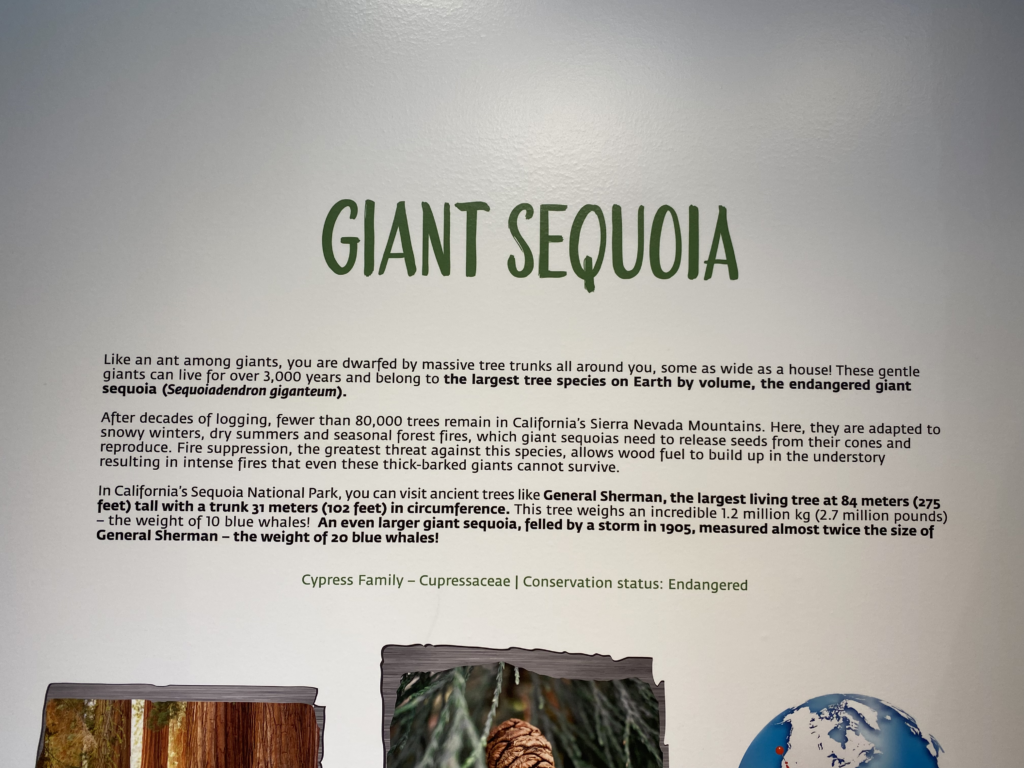
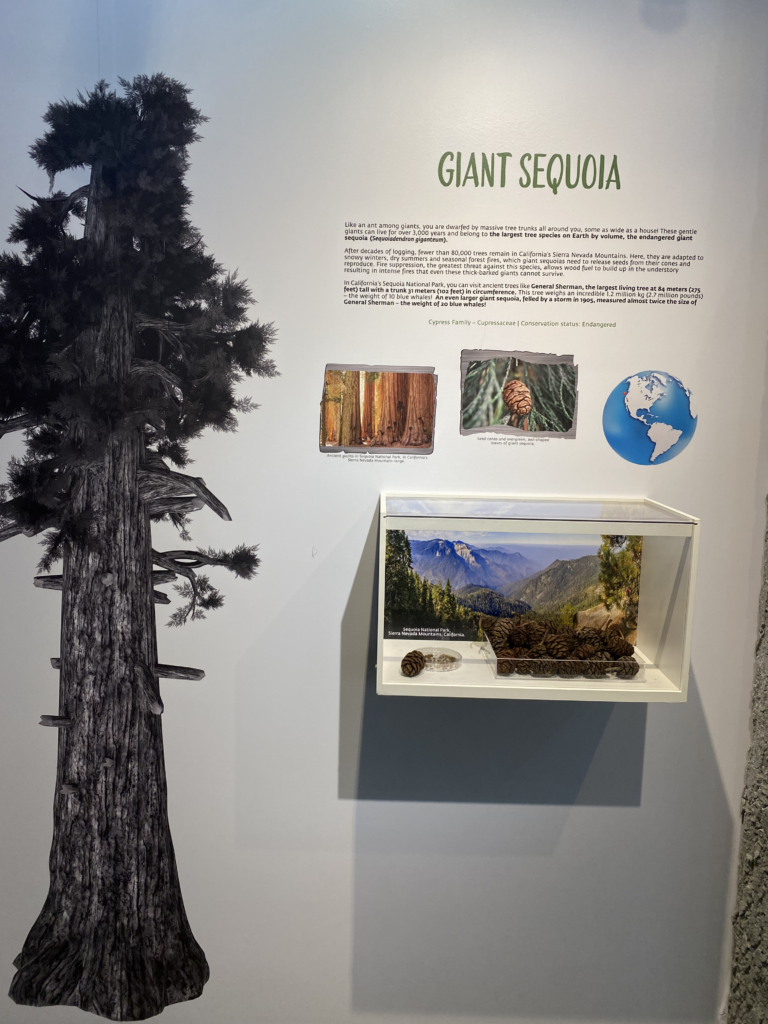
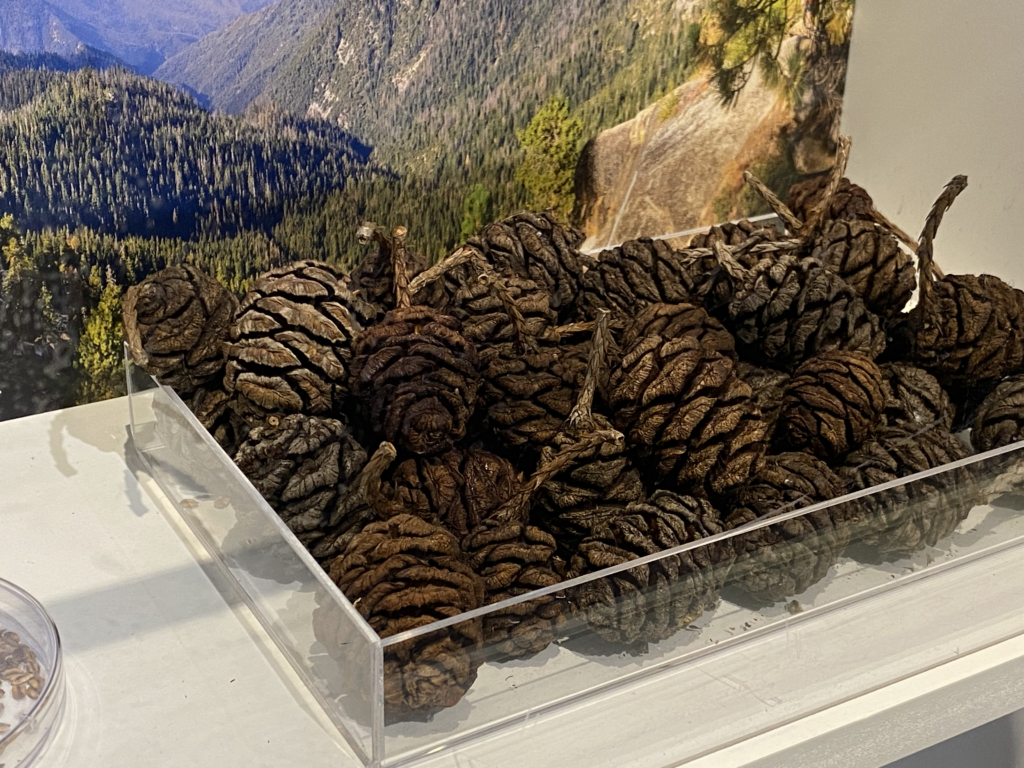
Coast Redwood
Looking up, you strain to see the tops of the towering tree trunks around you but they disappear into the mist above. It’s summer but it feels cool in the shade of northern California’s coast redwood forests, blanketed by year-round fog.
The tallest tree on Earth, the endangered coast redwood (Sequoia sempervirens) can reach dizzying heights of over 115 metres (377 feet) tall and live for over 2,000 years! They are so tall, their vascular system struggles to send water and nutrients from the roots to the highest branches. So, the coast redwood has adapted to having its head in the clouds by absorbing moisture from fog through tiny pores called stomata on the surface of its leaves. In dry summer months, up to 45% of their water is absorbed through their leaves!
The few remaining coast redwood forests are threatened by climate change, which reduces the coastal fog they need to survive. While protecting these forests is critical, arboreta and botanical gardens like VanDusen, are also helping to conserve these trees ex situ, outside their natural habitat.
Cypress Family – Cupressaceae | Conservation status: Endangered
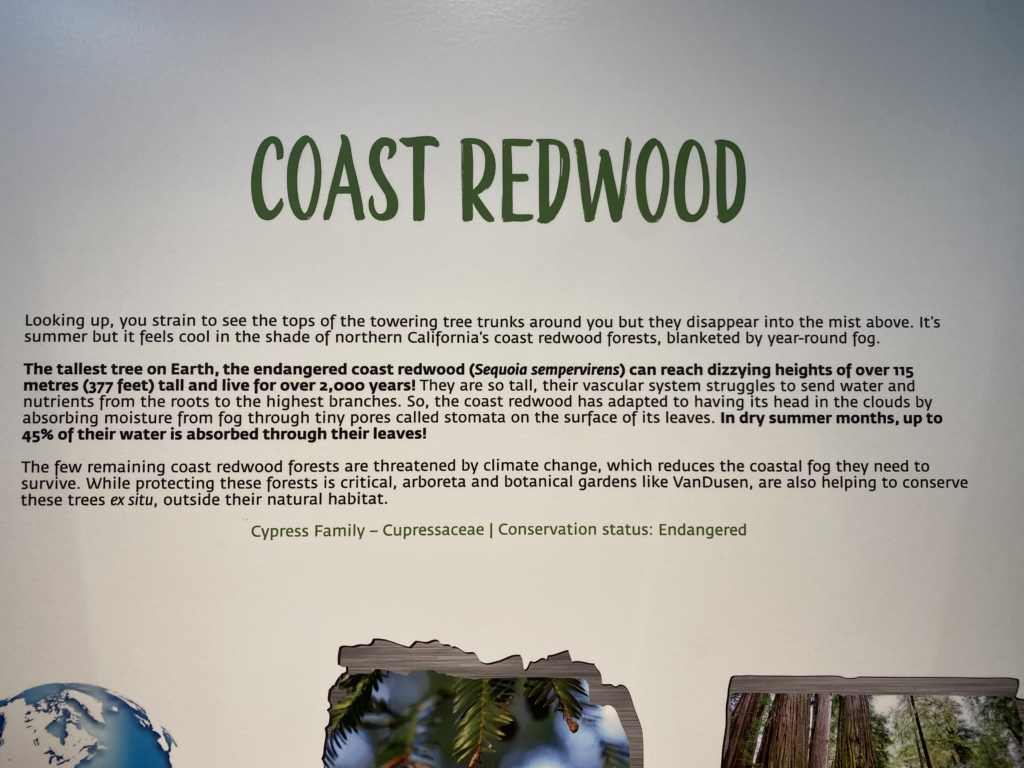
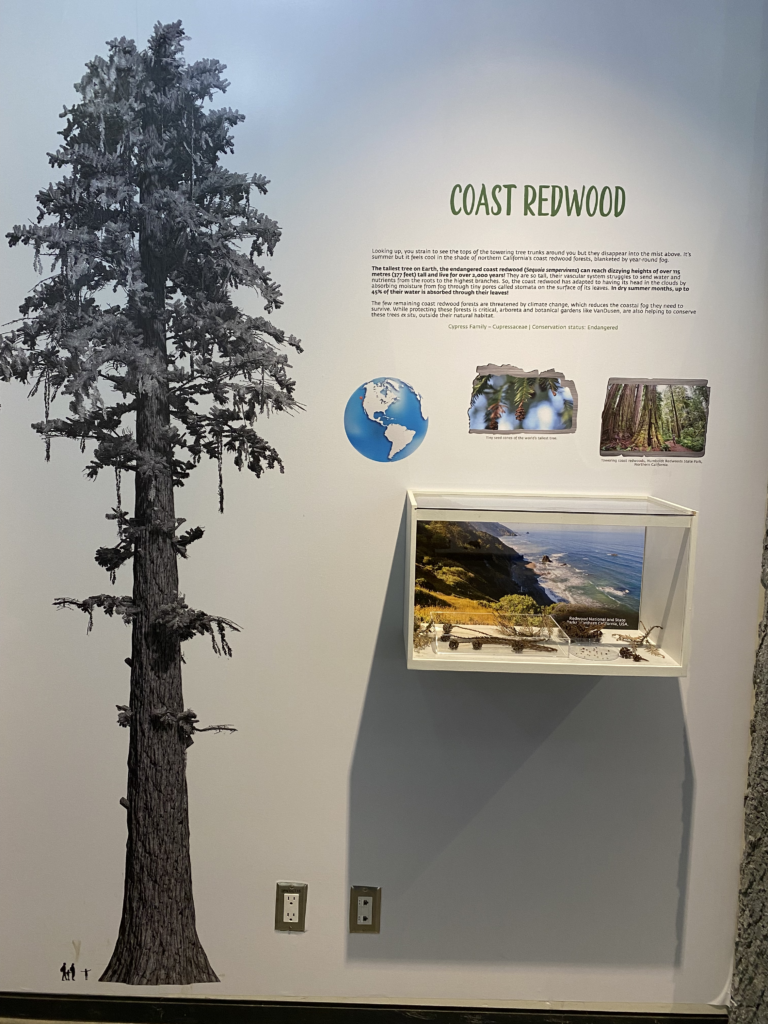
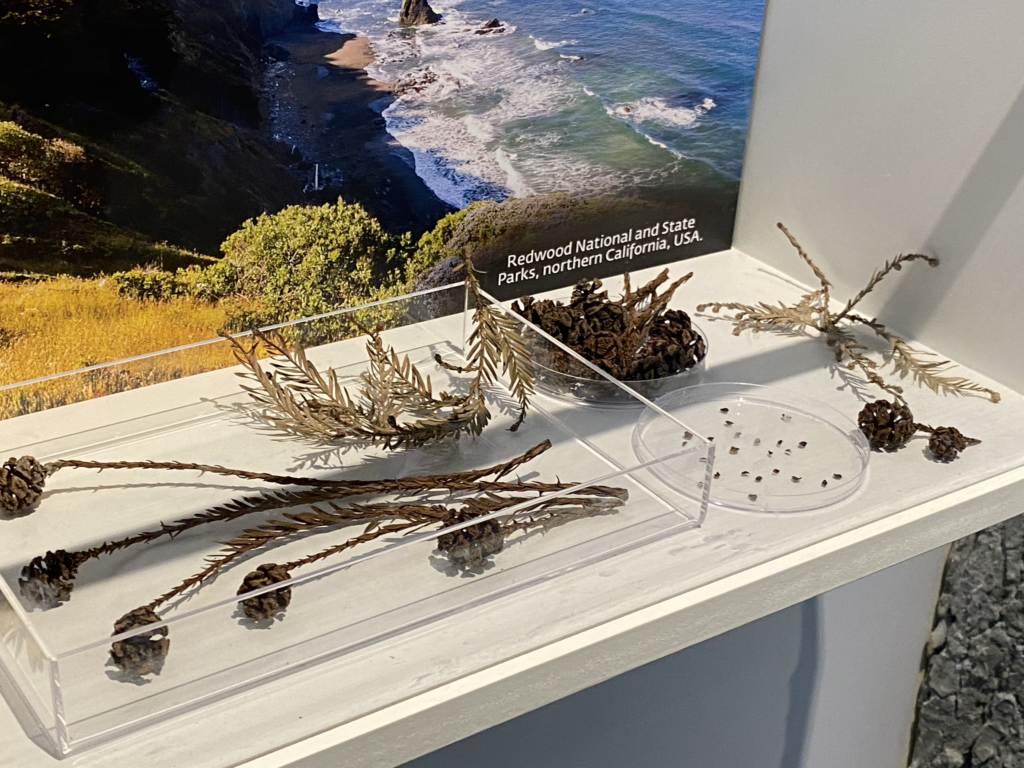
Tamarack
In nature’s gold rush, deciduous tamarack (Larix laricina) trees change colour in fall, weaving ribbons of gold through the boreal forests of black spruce, fir, pine, poplar, birch and willow that span Canada’s north before giving way to tundra at the Arctic Circle. Beyond, the boreal zone circles the northern hemisphere, storing more carbon than any other terrestrial ecosystem.
The largest intact forest on Earth, Canada’s boreal forests host a network of 1.5 million lakes, rivers and wetlands and provide habitat for millions of birds, woodland caribou, bison, elk, moose, bears and lynx. Oh, and plenty of mosquitoes and black files! Tamarack seeds and bark feed birds and showshoe hares, and the tree is the larval host for the Columbia silkmoth.
Ojibwe First Nations peoples call this tree mashikligwaatig which means “swamp tree”. They craft snowshoes from its flexible wood and make medicinal tea from the bark.
Pine Family – Pinaceae | Conservation status: Least Concern
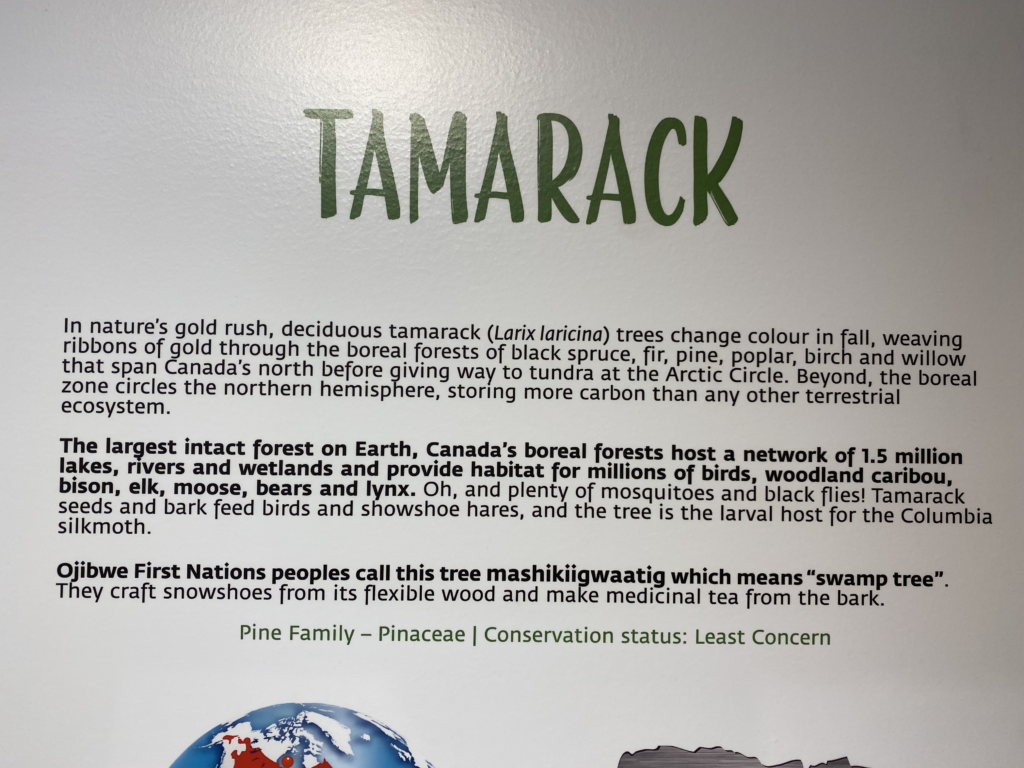
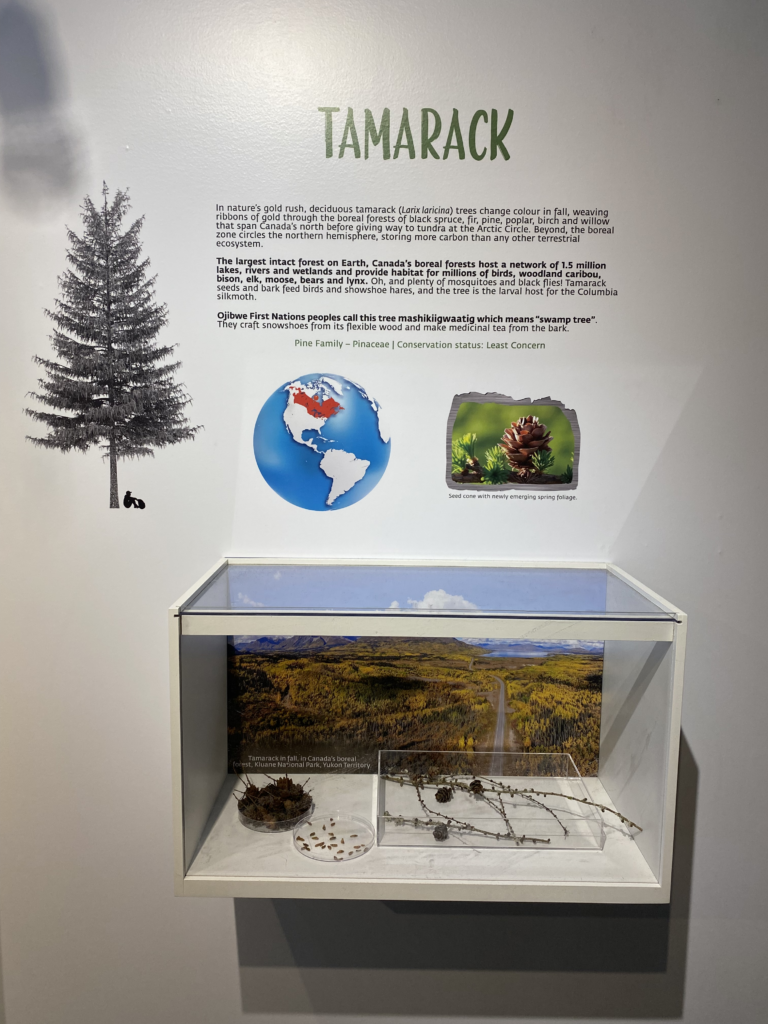
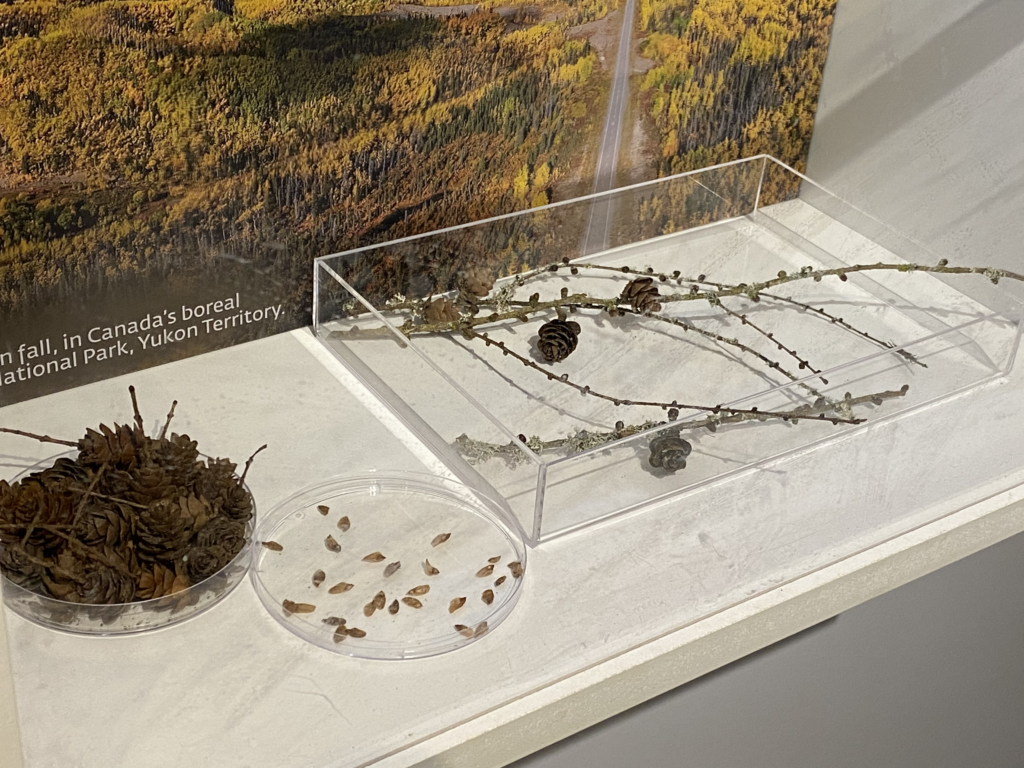
Golden Sitka Spruce
This tree is the stuff of legends! Glowing brightly against the dark rainforest, a majestic 300-year-old golden spruce grew on the shores of Haida Gwaii, a remote archipelago off BC’s central coast. It was a Sitka spruce (Pice sitchensis) with golden leaves caused by a rare mutation. The tree is sacred to indigenous Haida peoples, who named it K’lid K’iyaas, meaning “ancient tree”.
In 1997 the golden spruce starred in a real-life twisted tale of secrets and intrigue involving a murder plot (of a tree, that is), an odd recluse, a mysteriously shipwrecked kayak and an unsolved missing persons case that continues to spark rumours. For the full version of this true crime story, visit VanDusen’s library and check out the award-winning book, The Golden Spruce: A True Story of Myth, Madness and Greed by John Vaillant.
Canada’s tallest living tree is a Sitka spruce, measured at over 62.5 metres (205 feet) tall!
On the Pacific coast, old growth Sitka spruce forests provide critical habitat for wildlife, including the endangered marbled murrelet.
Pine Family – Pinaceae | Conservation status: Least Concern
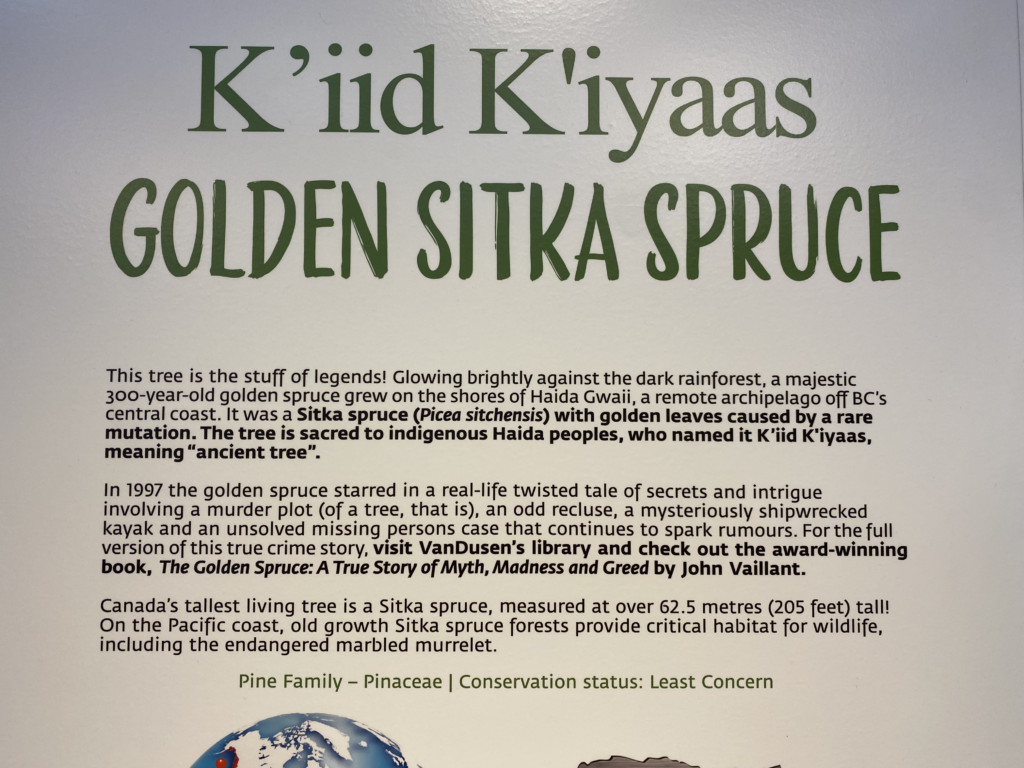
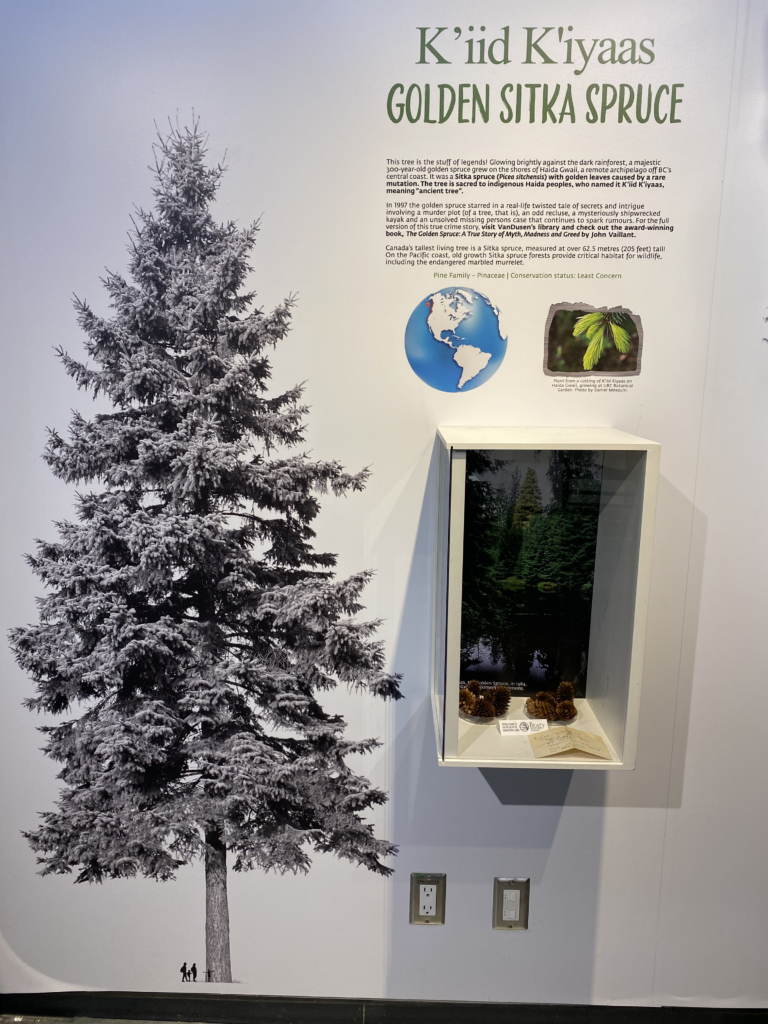
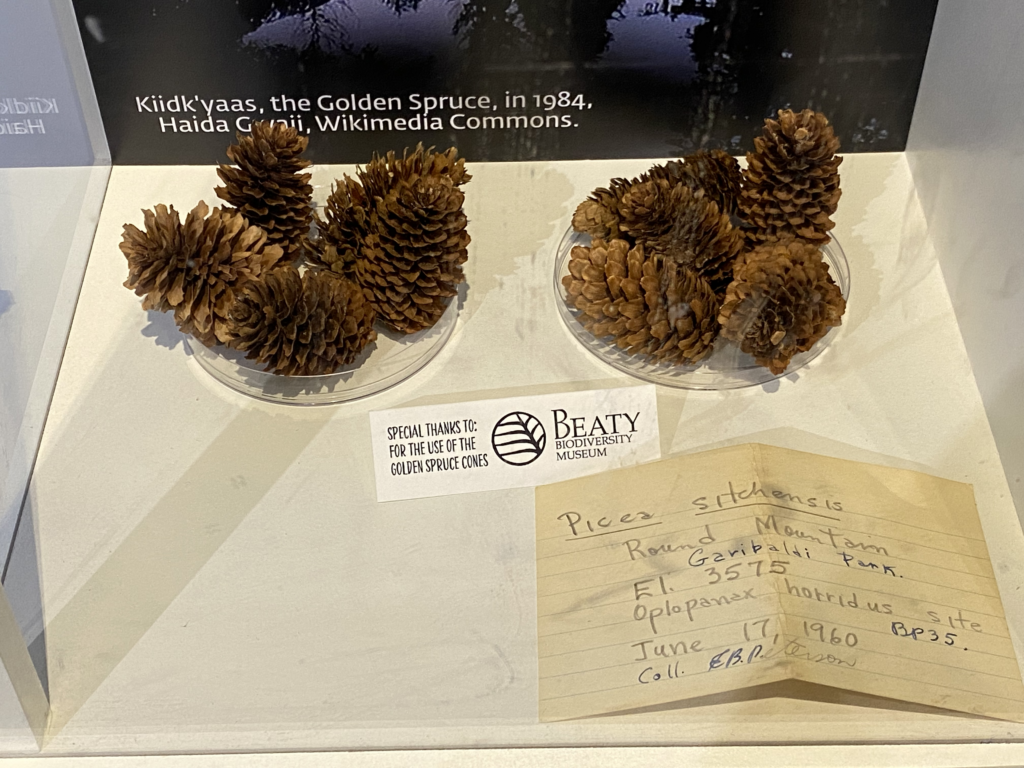
Douglas fir
Douglas-fir is known as c̓sey̓əɬp in hən̓q̓əmin̓əm̓ and ch’shay’ in sḵwx̱wú7mesh, the languages of the xʷməθkʷəy̓əm (Musqueam), sḵwx̱wú7mesh (Squamish) and səlilwətaɬ (Tsleil-Waututh) Nations. Fo thousands of years, they have used its wood for fuel, construction, tools and ceremonial items, while the pitch is used as a waterproof sealant and salve to treat colds.
The tallest tree in Canada, Coastal Douglas-fir (Pseudotsuga menziesii var. menziesii) grows in the Pacific temperate rainforest, where it can reach 5 metres (16 feet) wide, 120 metres (393 feet) tall and live for over 1,000 years. Its smaller cousin, Rocky Mountain Douglas-fir (Pseudotsuga menziesii var. glauca), grows east of the Coast and Cascade mountains.
Check out the tree trunks on display to see this conifer’s characteristic grooved bark. They were molded from a real Douglas-fir tree! According to a traditional origin story, the mother Douglas-fir tree offered shelter to mice who were fleeing a forest fire and when they hid inside her cones, they became the three-pointed cone bracts. Can you see tiny mouse tails and hind legs peeking out from the cones on display?
Pine Family – Pinaceae | Conservation status: Least Concern
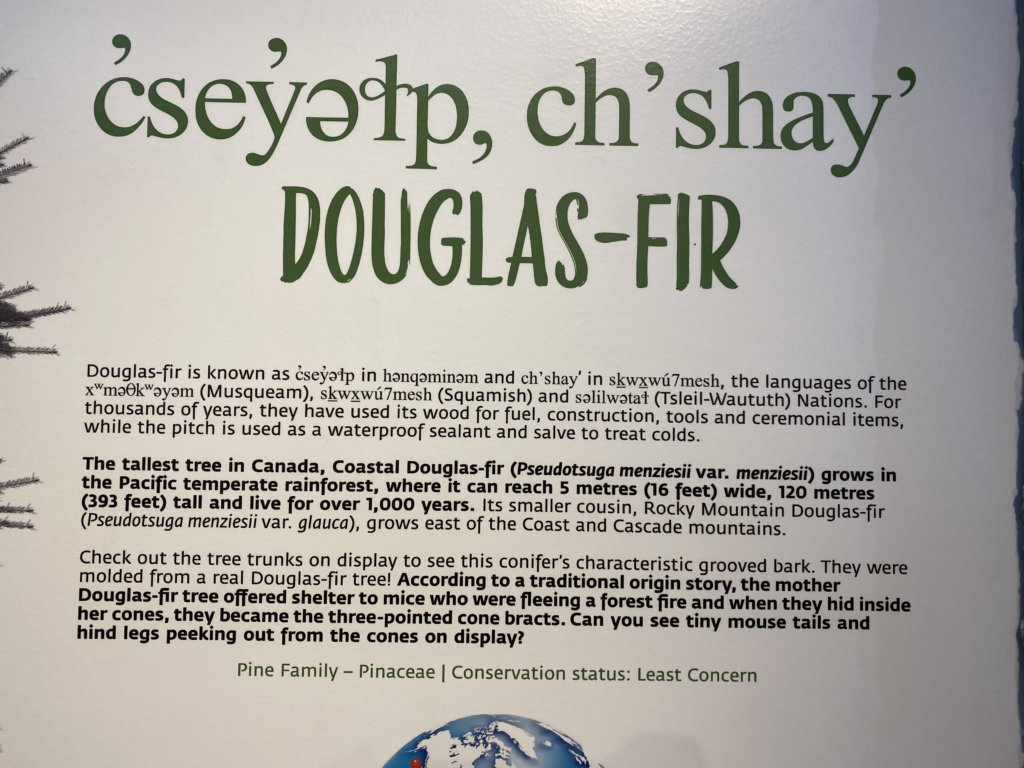
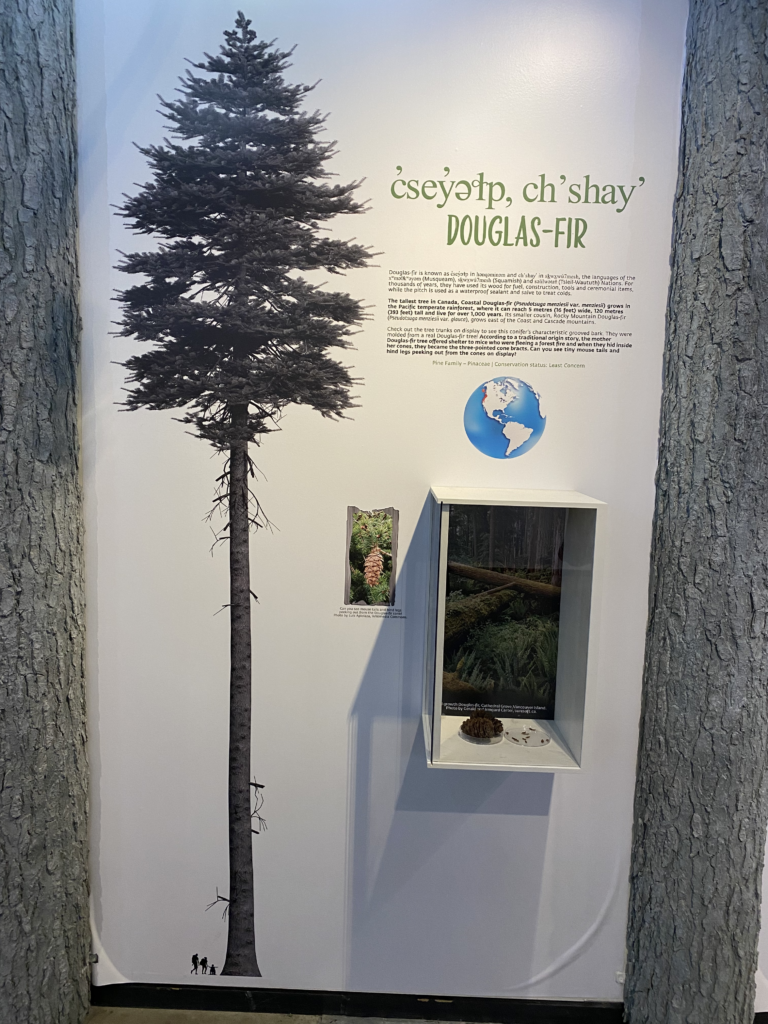
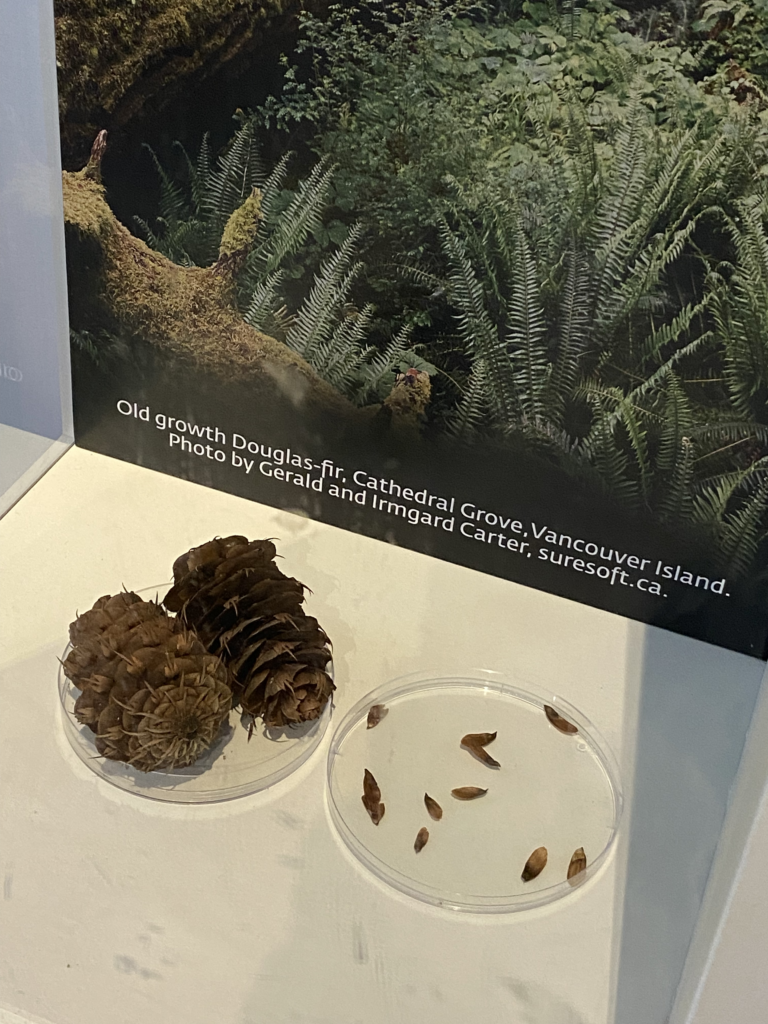
Ancient Pine
At over 4,800 years old, the ancient or Great Basin bristlecone pine (Pinus longaeva) is the world’s oldest living non-clonal organism! High atop California’s White Mountains, these trees are twisted into alien-like forms over centuries by unforgiving winds, freezing winters, intense sunlight and parched soils.
Their secret to long life? They slow down time by growing so slowly they only need a few living branches and green needles to photosynthesize, even after most of the tree has died away. When the whole tree eventually dies, natural resins preserve the wood allowing scientists to learn about climate patterns over thousands of years from the growth rings.
Named ‘Methuseleh’, the oldest living ancient pine is an incredible 4,853 years old! After a forestry student cut down a 4,844-year-old tree in 1964, the world was outraged and now the locations of the oldest ancient pines are kept secret to protect them.
Pine Family – Pinaceae | Conservation status: Lower Risk
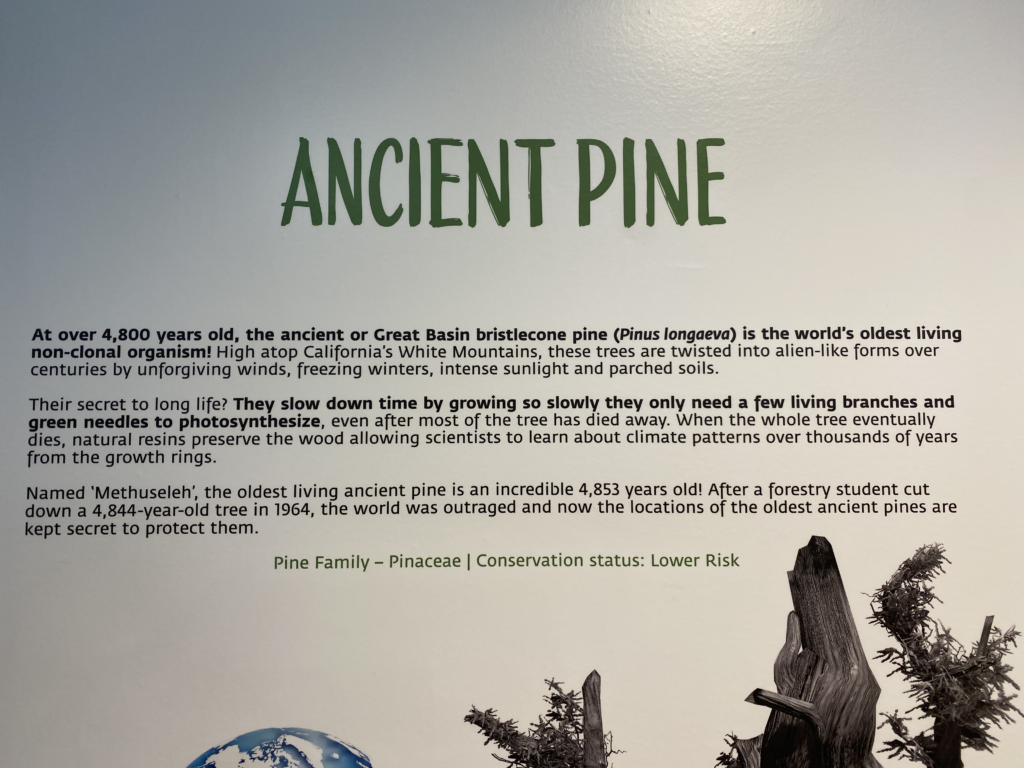
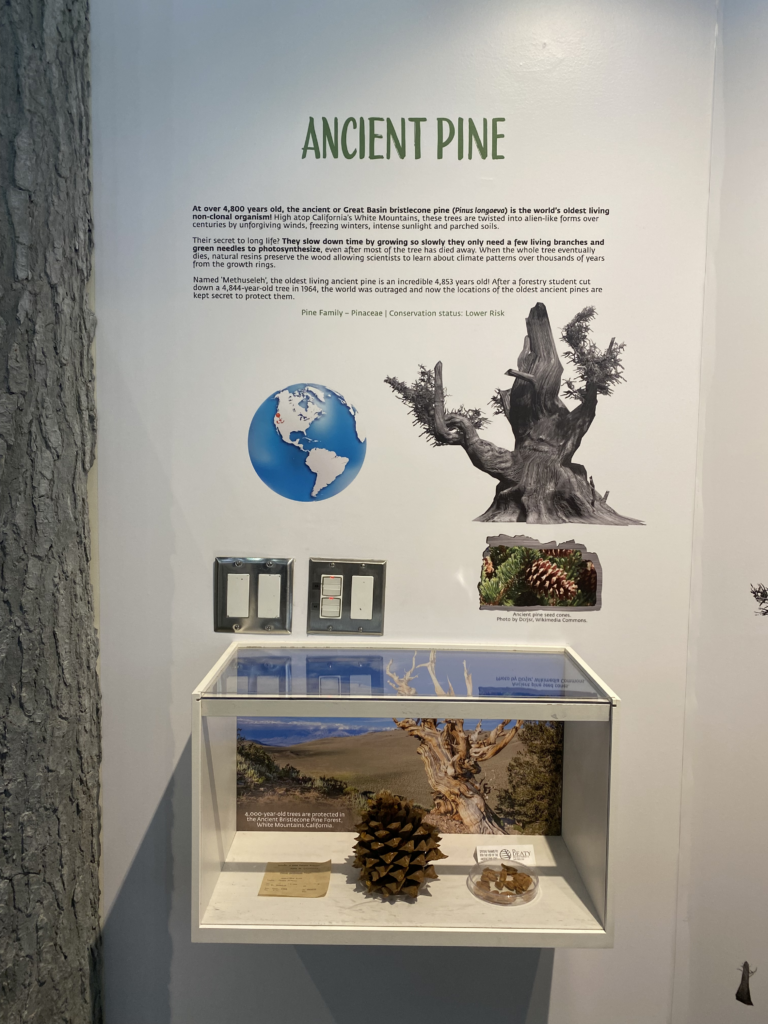
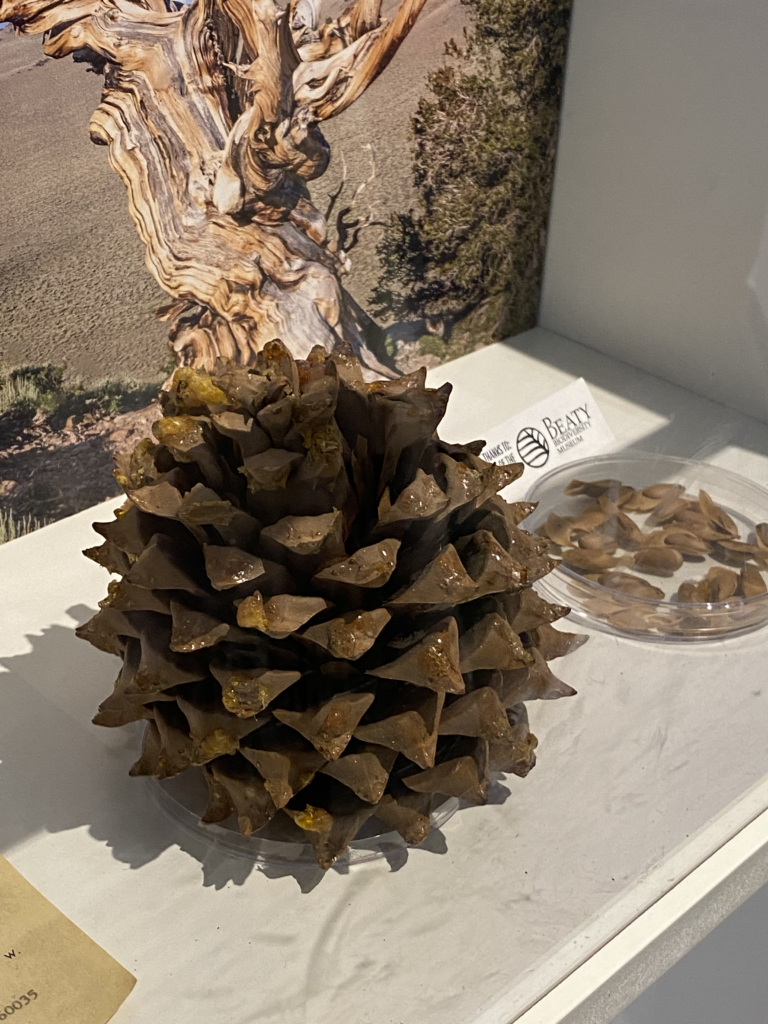
Swamp Cypress
As your boat drifts quietly between tree trunks emerging from the waters of Florida’s cypress swamps, the humid air buzzes with insects, bird calls and the splash of a creature lurking below the surface. A ripple appears at the side of your boat. Is it water dripping from a phantom orchid in the branches above? Or a water snake or alligator? Can you spot the alligator in the photo below?
Skip the mosquito bites and visit VanDusen’s R. Roy Forster Cypress Pond. Try not to trip over the quirky “cypress knees” or pneumatophores that jut up around the trunks and along the shore. The role of these specialized roots is hotly debated with theories suggesting their purpose is to aerate submerged roots, store carbohydrates and stabilize the tree in soggy soils. In fall, these deciduous conifers turn bronze before they drop their needles and become “bald” for winter.
Living for up to 600 years, swamp cypress (Taxodium distichum) grows to 50 metres (160 feet) tall in swamps and wetlands of the southeastern United States. There they host epiphytes or”air plants” in their branches, provide seeds for wild turkeys and waterfowl, and breeding habitat for frogs, salamanders and catfish.
Cypress Family – Cupressaceae | Conservation status: Least Concern
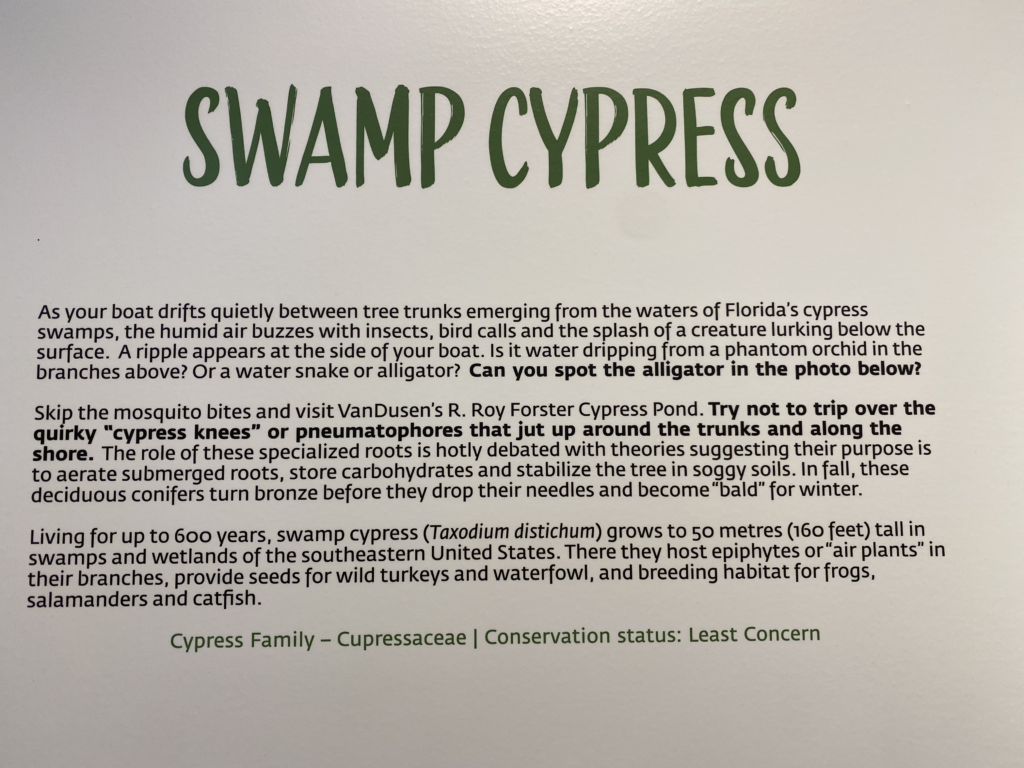
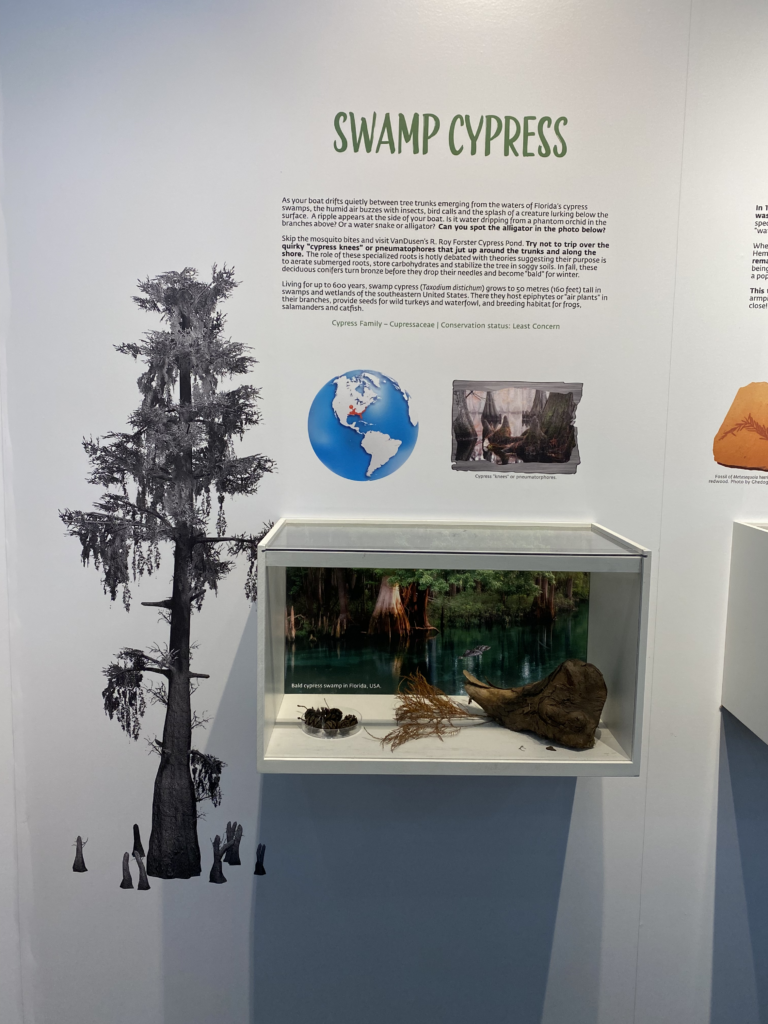
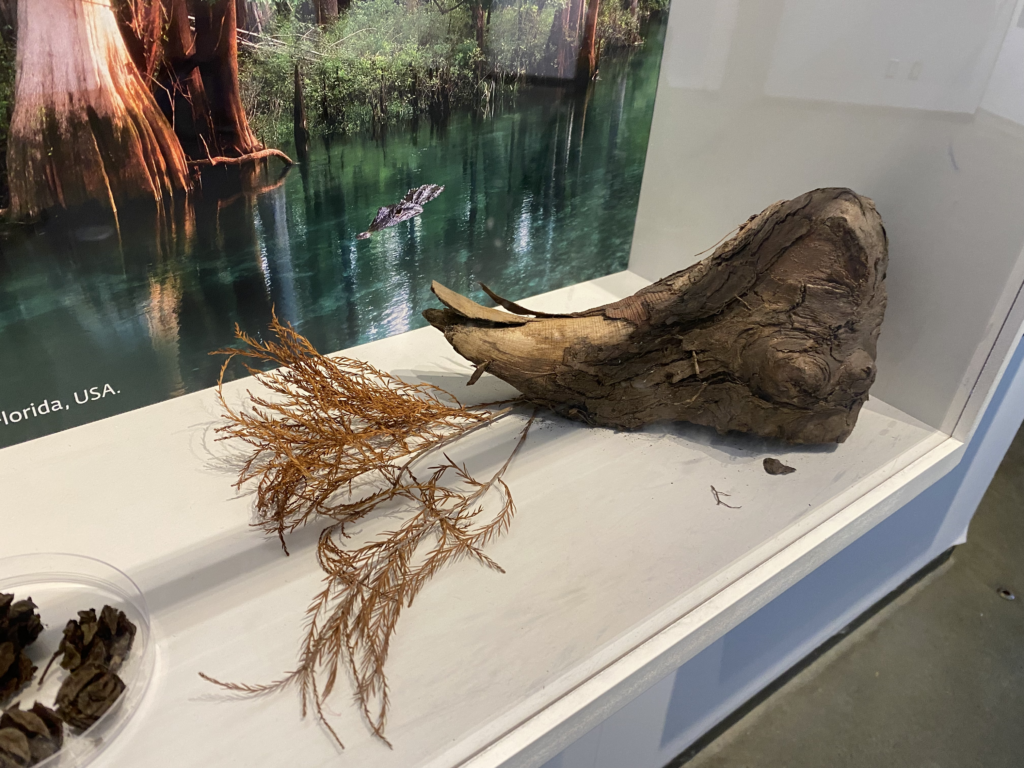
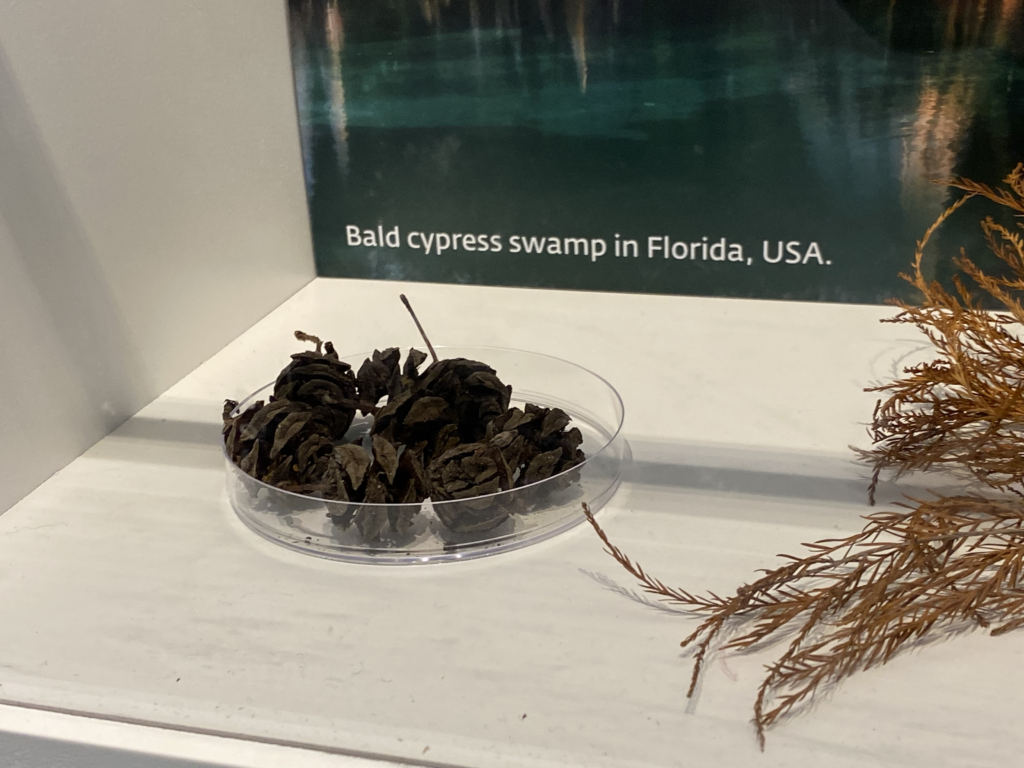
Dawn Redwood
In 1941, fossils revealed a new conifer, dawn redwood (Metasequoia glyptostroboides), which was thought to be extinct. Just a few years later, botanists were surprised to identify a living specimen in a village shrine in Hubei, China where the residents call it shui-sha (7K#), which means “water fir”.
When dinosaurs roamed the Earth in the late Cretaceous, Metasequoia forests covered the Northern Hemisphere, including Canada. Today, fewer than 5,000 wild trees of this “living fossil” remain, but this is an endangered species with a happy ending. Dawn redwood forests are being re-established in China and seeds have been shared around the world. Today dawn redwood is a popular ornamental tree and is protected in arboreta and botanical gardens like VanDusen.
This tree has armpits! Dawn redwood is easy to recognize by its feathery deciduous leaves and armpit-like depressions beneath each branch. Visit VanDusen’s Meconopsis Dell to see them up close!
Cypress Family – Cupressaceae | Conservation status: Endangered
